▼ Fourth gravitational wave detected! [09-29-17]
 A fourth gravitational wave has been detected - this time with help from Italy-based equipment - after two black holes collided, sending ripples through the fabric of space and time.
Gravitational waves were predicted by Albert Einstein a century ago as part of his theory of general relativity, but the first hard evidence of their existence came only in 2015, when two U.S. detectors found the first such signal.
The latest space-time ripples were detected on August 14, 2017 at 10.30 a.m. GMT (4 p.m. IST) when two giant black holes with masses about 31 and 25 times the mass of the Sun merged about 1.8 billion light-years away.
The newly produced spinning black hole has about 53 times the mass of our Sun.
While this new event is of astrophysical relevance, its detection comes with an additional asset: this is the first significant gravitational wave signal recorded by the Virgo detector.
The Virgo detector - an underground L-shaped instrument that tracks gravitational waves using the physics of laser light and space - recently underwent an upgrade, and while still less sensitive than its US counterparts, it was able to confirm the same signal.
Known as interferometers, these high-tech underground stations do not rely on light in the sky like a telescope does, but instead sense vibrations in space and can pick up the “chirp” created by a gravitational wave.
The space-time ripple was picked up by all three detectors at nearly the same time, in a first.
Previously, gravitational waves have been found using two U.S.-based detectors, which are the most sophisticated in the world - known as the Laser Interferometer Gravitational-Wave Observatory (LIGO) detectors in Livingston, Louisiana, and Hanford, Washington.
The first was found in September 2015 and announced to the public in early 2016, a historic achievement that culminated from decades of scientific research.
LIGO is funded by the National Science Foundation and operated by the California Institute of Technology (Caltech) and the Massachusetts Institute of Technology (MIT).
Virgo Collaboration: Know More A fourth gravitational wave has been detected - this time with help from Italy-based equipment - after two black holes collided, sending ripples through the fabric of space and time.
Gravitational waves were predicted by Albert Einstein a century ago as part of his theory of general relativity, but the first hard evidence of their existence came only in 2015, when two U.S. detectors found the first such signal.
The latest space-time ripples were detected on August 14, 2017 at 10.30 a.m. GMT (4 p.m. IST) when two giant black holes with masses about 31 and 25 times the mass of the Sun merged about 1.8 billion light-years away.
The newly produced spinning black hole has about 53 times the mass of our Sun.
While this new event is of astrophysical relevance, its detection comes with an additional asset: this is the first significant gravitational wave signal recorded by the Virgo detector.
The Virgo detector - an underground L-shaped instrument that tracks gravitational waves using the physics of laser light and space - recently underwent an upgrade, and while still less sensitive than its US counterparts, it was able to confirm the same signal.
Known as interferometers, these high-tech underground stations do not rely on light in the sky like a telescope does, but instead sense vibrations in space and can pick up the “chirp” created by a gravitational wave.
The space-time ripple was picked up by all three detectors at nearly the same time, in a first.
Previously, gravitational waves have been found using two U.S.-based detectors, which are the most sophisticated in the world - known as the Laser Interferometer Gravitational-Wave Observatory (LIGO) detectors in Livingston, Louisiana, and Hanford, Washington.
The first was found in September 2015 and announced to the public in early 2016, a historic achievement that culminated from decades of scientific research.
LIGO is funded by the National Science Foundation and operated by the California Institute of Technology (Caltech) and the Massachusetts Institute of Technology (MIT).
Virgo Collaboration: Know More
- The Virgo collaboration includes more than 280 physicists and engineers belonging to 20 different European research groups.
- This is just the beginning of observations with the network enabled by Virgo and LIGO working together
- With the next observing run planned for Fall 2018 we can expect such detections weekly or even more often.
|
▼ 2010-2020 is Decade of Innovation, IISF celebrations on course [09-29-17]
 India has made significant strides in scientific and technological development by also becoming the first nation to reach Mars in its maiden attempt.
India is facing various challenges and opportunities. Some of these important challenges are in the key sectors of clean water & energy, food, environment, climate, and healthcare.
This goal can be achieved, through developing scientific temper among the masses and by strengthening India’s science and technology institutions & furthering their basic research.
Emphasizing the role of technologies and innovation, India has declared 2010-20 as the ‘Decade of Innovation’.
The Ministry of Science and Technology, Ministry of Earth Sciences, and Vijnana Bharati (VIBHA) have come together to organize The India International Science Festival (IISF) every year, since 2015 to encourage scientific temper among the masses and showcasing Indian contribution in the field of S&T over the years.
The 3rd edition of IISF 2017 will be held in Chennai during 13-16 October, 2017 at various venues which include Anna University, Central Leather Research Institute (CLRI), Structural Engineering Research Centre (SERC), National Institute of Ocean Technology (NIOT) and IIT-Madras.
The prime objective of the festival is to instil scientific temper among the masses and showcasing India’s contribution in the field of S&T over the years.
It aims to build a strategy for rural India through the advancement of Science and Technology. Further, the science festival also intends to make innovation beneficial for the people and develop technology that is affordable to the masses.
Major Activities during the Festival will be:
1. Special Thematic Session on 'Deep Ocean Research'
2. Science & Technology Minister’s Conclave
3. Sensitizing Youth to Flagship Programs of Government (SYPOG)
4. Science Village: Parliament to Panchayat’’
5. National Meet on ‘Social Organisations and Institutions’: ‘Transforming India through Science & Technology’
6. Women Scientists & Entrepreneur’s Conclave
7. National Science Teachers Workshops (Focusing North East States)
8. Industry Academia Interaction
9. Mega Science, Technology & Industry Expo
10. India International Science Festival
11. Grassroots Innovators Summit
12. National Start-up Summit
13. Round Table Meet on Mass Communication
14. World Record attempt will be made in “Largest Biology Lesson”
15. National Level Competitions—Ideas for Bharat Nirman
16. Outreach Programme in R&D Labs
17. Satellite Seminars
18. Cultural Events
The Govt of India is launching a National Mission on Deep Ocean Research which will bring in huge economic benefits by harnessing the ocean resources (water, energy and minerals).
A special thematic session on Deep Ocean Research will be held.
‘Science for New India’ aims to provides a platform to young students, scientists and technocrats from across India for the exchange of knowledge & ideas in the line of flagship programs like 'Swachh Bharat Abhiyan', ‘Swasth Bharat Abhiyan’, 'Make in India', 'Digital India’, ‘Smart Villages’, 'Smart Cities’, 'Namami Gange', 'Unnath Bharath Abhiyan', etc.
An important event of the IISF-2017 is the Science Village program which is linked with the Pradhan Manthri Sansad Adarsh Gram Yojana to reach out to the rural masses and propagate science to the extent of seeking scientific solutions to the diverse challenges facing our society, particularly rural India..
As a unique programme of IISF 2017, a Women Scientists & Entrepreneur’s Conclave titled “Game Changers Driving Science for New India” would be organized to promote and encourage science education and entrepreneurship among the women.
The aim of the programme is to develop new entrepreneurship and also explore new vistas of opportunities in the field of science and technology among the women.
National Innovation Foundation (NIF) will be organising the ‘Innovation Exhibition’ as a part of the Grassroots Innovators Summit, which aims at providing a common platform for various stakeholders—from innovators, students, researchers to policy makers.
The Round Table Meet on Mass Communication will address the various methods and techniques to popularize science and its applications.
In the International Science Film Festival, Films on science focusing on science fiction from India and abroad will be screened.
IISF: Know More India has made significant strides in scientific and technological development by also becoming the first nation to reach Mars in its maiden attempt.
India is facing various challenges and opportunities. Some of these important challenges are in the key sectors of clean water & energy, food, environment, climate, and healthcare.
This goal can be achieved, through developing scientific temper among the masses and by strengthening India’s science and technology institutions & furthering their basic research.
Emphasizing the role of technologies and innovation, India has declared 2010-20 as the ‘Decade of Innovation’.
The Ministry of Science and Technology, Ministry of Earth Sciences, and Vijnana Bharati (VIBHA) have come together to organize The India International Science Festival (IISF) every year, since 2015 to encourage scientific temper among the masses and showcasing Indian contribution in the field of S&T over the years.
The 3rd edition of IISF 2017 will be held in Chennai during 13-16 October, 2017 at various venues which include Anna University, Central Leather Research Institute (CLRI), Structural Engineering Research Centre (SERC), National Institute of Ocean Technology (NIOT) and IIT-Madras.
The prime objective of the festival is to instil scientific temper among the masses and showcasing India’s contribution in the field of S&T over the years.
It aims to build a strategy for rural India through the advancement of Science and Technology. Further, the science festival also intends to make innovation beneficial for the people and develop technology that is affordable to the masses.
Major Activities during the Festival will be:
1. Special Thematic Session on 'Deep Ocean Research'
2. Science & Technology Minister’s Conclave
3. Sensitizing Youth to Flagship Programs of Government (SYPOG)
4. Science Village: Parliament to Panchayat’’
5. National Meet on ‘Social Organisations and Institutions’: ‘Transforming India through Science & Technology’
6. Women Scientists & Entrepreneur’s Conclave
7. National Science Teachers Workshops (Focusing North East States)
8. Industry Academia Interaction
9. Mega Science, Technology & Industry Expo
10. India International Science Festival
11. Grassroots Innovators Summit
12. National Start-up Summit
13. Round Table Meet on Mass Communication
14. World Record attempt will be made in “Largest Biology Lesson”
15. National Level Competitions—Ideas for Bharat Nirman
16. Outreach Programme in R&D Labs
17. Satellite Seminars
18. Cultural Events
The Govt of India is launching a National Mission on Deep Ocean Research which will bring in huge economic benefits by harnessing the ocean resources (water, energy and minerals).
A special thematic session on Deep Ocean Research will be held.
‘Science for New India’ aims to provides a platform to young students, scientists and technocrats from across India for the exchange of knowledge & ideas in the line of flagship programs like 'Swachh Bharat Abhiyan', ‘Swasth Bharat Abhiyan’, 'Make in India', 'Digital India’, ‘Smart Villages’, 'Smart Cities’, 'Namami Gange', 'Unnath Bharath Abhiyan', etc.
An important event of the IISF-2017 is the Science Village program which is linked with the Pradhan Manthri Sansad Adarsh Gram Yojana to reach out to the rural masses and propagate science to the extent of seeking scientific solutions to the diverse challenges facing our society, particularly rural India..
As a unique programme of IISF 2017, a Women Scientists & Entrepreneur’s Conclave titled “Game Changers Driving Science for New India” would be organized to promote and encourage science education and entrepreneurship among the women.
The aim of the programme is to develop new entrepreneurship and also explore new vistas of opportunities in the field of science and technology among the women.
National Innovation Foundation (NIF) will be organising the ‘Innovation Exhibition’ as a part of the Grassroots Innovators Summit, which aims at providing a common platform for various stakeholders—from innovators, students, researchers to policy makers.
The Round Table Meet on Mass Communication will address the various methods and techniques to popularize science and its applications.
In the International Science Film Festival, Films on science focusing on science fiction from India and abroad will be screened.
IISF: Know More
- World record attempts have been a key part of IISF since 2015; in IISF 2015, students took a successful shot at the Guinness world record for the World's Largest Science Lesson at IIT Delhi.
- In IISF 2016, at NPL, Pusa, a group of 550 students attempted the world record for Largest Gathering of People Dressed as Nobel Prize-winning scientist Albert Einstein.
- In IISF 2017, a World Record attempt will be made in “Largest Biology Lesson”. 1000 students from Class 9th & 10th will be gathering at the venue in Chennai for this attempt.
- The IISF is not only a celebration of science and technology through exhibitions and relevant events, but also has been geared up to spread awareness on the flagship programs like ‘Swachh Bharat Abhiyan’, ‘Swasth Bharat Abhiyan’, ‘Make in India’ and ‘Digital India’.
|
▼ Indian Railways collaborates with ISRO to make trains safer [09-29-17]
 Indian Railways is working with the Indian Space Research Organisation (ISRO) to devise safety mechanisms to make travel by trains more safer.
There have been a slew of train derailment incidents last month which saw the exit of Suresh Prabhu as the railway minister in the Cabinet reshuffle in Sept 2017.
Indian railways has been an early adopter of computers which could have been also expanded for various operational processes like safety.
Way back in 1960s, railways started using computers in a small way and by 1985 passenger reservations system were all computerised.
Modern technologies like artificial intelligence and machine learning are going to change the world works and India has opportunity to look at what is latest across the world and bring it to the country.
Round the clock access of connectivity and electricity is dream of billions of Indians and the government is making efforts to achieve it. Indian Railways is working with the Indian Space Research Organisation (ISRO) to devise safety mechanisms to make travel by trains more safer.
There have been a slew of train derailment incidents last month which saw the exit of Suresh Prabhu as the railway minister in the Cabinet reshuffle in Sept 2017.
Indian railways has been an early adopter of computers which could have been also expanded for various operational processes like safety.
Way back in 1960s, railways started using computers in a small way and by 1985 passenger reservations system were all computerised.
Modern technologies like artificial intelligence and machine learning are going to change the world works and India has opportunity to look at what is latest across the world and bring it to the country.
Round the clock access of connectivity and electricity is dream of billions of Indians and the government is making efforts to achieve it.
|
▼ From 140 to 280: Twitter doubles characters in Tweet! [09-28-17]
 Twitter is testing allowing tweets to be expanded to 280 characters - double the existing limit - in the latest effort to boost flagging growth at the social network.
San Francisco-based Twitter said on 26th Sept 2017 that the new limit, a major shift for the messaging platform known for its 140-character tweets, aims to address “a major cause of frustration” for many users.
Twitter chief executive Jack Dorsey fired off what may be one of the first expanded tweets.
“This is a small change, but a big move for us,” he wrote, calling the previous limit was an “arbitrary choice”.
Twitter planned to leave the old limit in place for tweets in Japanese, Chinese and Korean because internal data showed written characters in those languages packed plenty into the allotted space.
Twitter, which became a public company in 2013, has never reported a profit, even though it has built a loyal base of celebrities, journalists and political figures, including prolific tweeter US President Donald Trump.
In its most recent quarter, Twitter reported its base of monthly active users was unchanged at 328 million compared to the first three months of the year and up just five percent from a year earlier.
Its growth has failed to keep pace with social network leader Facebook, which has some two billion users, and Facebook-owned Instagram, with 800 million.
Twitter has been seeking to draw in users by offering more video, including live streaming of sporting events, aiming to broaden its appeal.
Reaction on Twitter was mixed, with some lobbying for the original cap and the pressure it applied to succinctly express thoughts.
Many others on Twitter welcomed the news and said raising the character cap was long overdue.
Some people already resort to long strings of rapid-fire tweets, known as “Twitter storms,” to string together lengthy comment.
The messaging platform reported a net loss of $116 million in the second quarter, slightly wider than its $107 million loss a year ago.
It remained an open question whether the new tweet limit would ignite the growth an engagement Twitter needs to compete in the fast-moving social media segment.
The move by Twitter could also be rendered moot by lifestyle changes brought about by trends in voice-commanded digital assistants and looking at the world through mixed-reality glasses, according to Gartner analysts. Twitter is testing allowing tweets to be expanded to 280 characters - double the existing limit - in the latest effort to boost flagging growth at the social network.
San Francisco-based Twitter said on 26th Sept 2017 that the new limit, a major shift for the messaging platform known for its 140-character tweets, aims to address “a major cause of frustration” for many users.
Twitter chief executive Jack Dorsey fired off what may be one of the first expanded tweets.
“This is a small change, but a big move for us,” he wrote, calling the previous limit was an “arbitrary choice”.
Twitter planned to leave the old limit in place for tweets in Japanese, Chinese and Korean because internal data showed written characters in those languages packed plenty into the allotted space.
Twitter, which became a public company in 2013, has never reported a profit, even though it has built a loyal base of celebrities, journalists and political figures, including prolific tweeter US President Donald Trump.
In its most recent quarter, Twitter reported its base of monthly active users was unchanged at 328 million compared to the first three months of the year and up just five percent from a year earlier.
Its growth has failed to keep pace with social network leader Facebook, which has some two billion users, and Facebook-owned Instagram, with 800 million.
Twitter has been seeking to draw in users by offering more video, including live streaming of sporting events, aiming to broaden its appeal.
Reaction on Twitter was mixed, with some lobbying for the original cap and the pressure it applied to succinctly express thoughts.
Many others on Twitter welcomed the news and said raising the character cap was long overdue.
Some people already resort to long strings of rapid-fire tweets, known as “Twitter storms,” to string together lengthy comment.
The messaging platform reported a net loss of $116 million in the second quarter, slightly wider than its $107 million loss a year ago.
It remained an open question whether the new tweet limit would ignite the growth an engagement Twitter needs to compete in the fast-moving social media segment.
The move by Twitter could also be rendered moot by lifestyle changes brought about by trends in voice-commanded digital assistants and looking at the world through mixed-reality glasses, according to Gartner analysts.
|
▼ Stratolaunch set to launch world's largest aircraft, first phase of engine testing complete! [09-27-17]
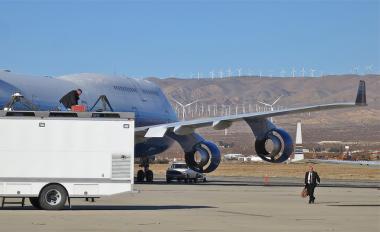 The dream of building world's largest aircraft is a step closer to reality with the private spaceflight company Stratolaunch, which is spearheading the project, having successfully hit a milestone last week by completing the first phase of engine testing.
Stratolaunch was founded by Paul G. Allen, the man who funded first private spacecraft SpaceShipOne to carry a civilian into suborbital space and safely home again.
It aims at providing convenient, reliable, and routine access to low Earth orbit (LEO) that will help researchers collect data in science, research, and technology from space.
The team has completed fuel testing that includes testing all six fuel tanks to ensure proper operations and each of the six fuel tanks were filled independently to ensure proper operations of fuel mechanisms and to validate the tanks were properly sealed.
The company said that they have also begun testing the flight control system and have so far exercised the full limits of motion and rate of deflection of control surfaces on the wing and stabilisers.
The engine testing was conducted with a build-up approach consisting of three phases - dry motor, wet motor and then each engine was started one at a time and allowed to idle.
Each of the engines operated as expected.
The company would “continue to test the aircraft's engines at higher power levels and varying configurations, culminating to the start of taxi tests.”
Stratolaunch: World's Largest Aircraft The dream of building world's largest aircraft is a step closer to reality with the private spaceflight company Stratolaunch, which is spearheading the project, having successfully hit a milestone last week by completing the first phase of engine testing.
Stratolaunch was founded by Paul G. Allen, the man who funded first private spacecraft SpaceShipOne to carry a civilian into suborbital space and safely home again.
It aims at providing convenient, reliable, and routine access to low Earth orbit (LEO) that will help researchers collect data in science, research, and technology from space.
The team has completed fuel testing that includes testing all six fuel tanks to ensure proper operations and each of the six fuel tanks were filled independently to ensure proper operations of fuel mechanisms and to validate the tanks were properly sealed.
The company said that they have also begun testing the flight control system and have so far exercised the full limits of motion and rate of deflection of control surfaces on the wing and stabilisers.
The engine testing was conducted with a build-up approach consisting of three phases - dry motor, wet motor and then each engine was started one at a time and allowed to idle.
Each of the engines operated as expected.
The company would “continue to test the aircraft's engines at higher power levels and varying configurations, culminating to the start of taxi tests.”
Stratolaunch: World's Largest Aircraft
- It is the world's largest aircraft by wingspan and is the largest all-composite plane ever built, according to Stratolaunch website.
- It uses "Boeing 747 engines for a payload capacity of over 500,000 lbs
- It has an operational range of approximately 2,000 nautical miles.
- Wing span: 385 feet
- Length: 238 feet
- Tail height: 50 feet
- Propulsion: 6X Pratt & Whitney PW4056 Engines
- Max takeoff weight: 1,3000,000 LBS
- Stratolaunch is expected to be fully operational by the end of this decade.
- It is currently under construction at the Mojave Air & Space Port in Mojave, California.
|
▼ Now, scientists find plastic chunks in North Pole sea ice! [09-27-17]
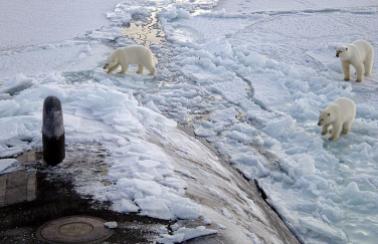 According to reports, scientists have discovered sizeable chunks of plastic near the North Pole, raising fears that melting ice will allow more of the material to be released into the Arctic Ocean - with detrimental effects on wildlife.
A team of scientists found polystyrene chunks 1,609 kilometres from the North Pole in the area that was previously inaccessible because of sea ice.
They found two large pieces on the edge of ice flows between 77 degree and 80 degree north, in the middle of the international waters of the central Arctic Ocean.
It is one of the most northerly sightings of such debris in the world's oceans, which are increasingly polluted by plastics and confirm just how far plastic pollution has spread.
This comes at a time when climate change-induced melting of Arctic ice has been a pressing matter for scientists across the world.
The finding has prompted fears that as the ice melts, because of climate change, plastic that has long been trapped in it is flowing into the Arctic.
Finding pieces of rubbish like this is a worrying sign that melting ice may be allowing high levels of pollution to drift into these area.
This is potentially very dangerous for the Arctic's wildlife.
More than five trillion pieces of plastic are estimated floating on the surface of the world's oceans.
It has been claimed that there is now enough plastic to form a permanent layer in the fossil record.
A significant concern is that large plastic pieces can break down into “micro plastics” that are tiny particles that are accidentally consumed by filter-feeding animals.
The particles remain in animals' bodies and are passed up the food chain, threatening wildlife at all levels from zooplankton to apex predators such as polar bears.
Many rivers that are often a source of plastic pollution lead into the Arctic Ocean, but plastic pollution has been literally trapped into the ice.
Now the ice is melting scientists believe micro plastics are being released into the Arctic.
Some projections indicate that the entire Arctic Ocean will be ice-free in summer by 2050, allowing human exploitation such as commercial fishing, shipping and industry of the newly opened waters.
Plastic Waste: Know More According to reports, scientists have discovered sizeable chunks of plastic near the North Pole, raising fears that melting ice will allow more of the material to be released into the Arctic Ocean - with detrimental effects on wildlife.
A team of scientists found polystyrene chunks 1,609 kilometres from the North Pole in the area that was previously inaccessible because of sea ice.
They found two large pieces on the edge of ice flows between 77 degree and 80 degree north, in the middle of the international waters of the central Arctic Ocean.
It is one of the most northerly sightings of such debris in the world's oceans, which are increasingly polluted by plastics and confirm just how far plastic pollution has spread.
This comes at a time when climate change-induced melting of Arctic ice has been a pressing matter for scientists across the world.
The finding has prompted fears that as the ice melts, because of climate change, plastic that has long been trapped in it is flowing into the Arctic.
Finding pieces of rubbish like this is a worrying sign that melting ice may be allowing high levels of pollution to drift into these area.
This is potentially very dangerous for the Arctic's wildlife.
More than five trillion pieces of plastic are estimated floating on the surface of the world's oceans.
It has been claimed that there is now enough plastic to form a permanent layer in the fossil record.
A significant concern is that large plastic pieces can break down into “micro plastics” that are tiny particles that are accidentally consumed by filter-feeding animals.
The particles remain in animals' bodies and are passed up the food chain, threatening wildlife at all levels from zooplankton to apex predators such as polar bears.
Many rivers that are often a source of plastic pollution lead into the Arctic Ocean, but plastic pollution has been literally trapped into the ice.
Now the ice is melting scientists believe micro plastics are being released into the Arctic.
Some projections indicate that the entire Arctic Ocean will be ice-free in summer by 2050, allowing human exploitation such as commercial fishing, shipping and industry of the newly opened waters.
Plastic Waste: Know More
- Plastic waste is a menace that is the result of industrialization and to an extent, human activities, without realizing that it ends up affecting our health as well.
- Plastic is considered inexpensive and durable, which is why it is most commonly used for packaging.
- However, due to its slow degradation process, plastics can severely affect living organisms, especially marine life, through entanglement, direct ingestion of plastic waste, or through exposure to chemicals within plastics that cause interruptions in biological functions
|
▼ Moon, Mars volcanic too, lava tubes indicate support for human habitation [09-27-17]
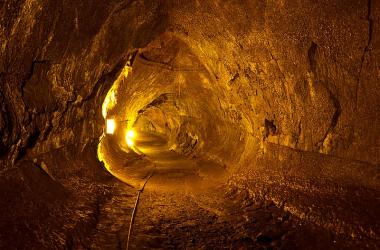 Like on Earth, Moon and Mars also have volcanic features - such as lava tubes.
Lava tubes are basically lava caves formed in one of two ways: either through the crusting over of lava channels, or more rarely, from pahoehoe flows where the lava is moving under the surface. After the lava leaves, it can leave behind a tunnel.
Sometimes, the lava might re-emerge and might be injected into its old tunnels (due to the low resistance); once there, it expands and leaves behind even larger tunnels, sometimes reaching impressive sizes.
Sometimes, complex tunnel systems are formed, connected to each other and to the surface.
By far the largest known lava tubes in the Solar System are on Venus. However, such tubes have also been discovered on the Moon, and especially on Mars.
Considering the innumerable lava flows and lava channels on the flanks of Olympus Mons, it makes a lot of sense to expect truly gargantuan lava tube systems on the Red Planet.
Scientists now believe that these tunnels can be used to shield future explorers from the massive amounts of radiation they would be exposed to on the surface.
Researchers can detect these tunnels remotely, through gravitational remote sensing. Things stand like this: we talk about the gravitational pull of a celestial body (let’s say, the Earth), but the gravitational field isn’t uniform.
The same goes for the Moon, Mars, and everything else — nothing is really uniform.
By studying localized gravitational anomalies, underground cavities - such as lava tunnels - can be discovered. But researchers are also working on more advanced methods.
A concept for a radar system specifically designed to detect lava tubes on the Moon from orbit was presented.
The idea is to send an electromagnetic pulse towards the planet and then detect a specific signature associated with these tunnels.
Although it’s still early stages, there are promising results which may be used in the near future.
The studies we have developed show that a multi- frequency sounding system is the best option for detecting lava tubes of very different dimensions.
The electromagnetic simulations show that lava tubes have unique electromagnetic signatures, which can be detected from orbit irrespective of their orientation to the radar movement direction.
Therefore, a mission carrying this instrument would enable a crucial step towards finding safe habitats on the Moon for human colonisation.
Geologists have also learned that the distribution of such systems can be generous enough to facilitate the establishment of large stations, or perhaps even entire cities.
On Earth, they can be up to thirty metres across. In the lower gravity environment of Mars, we see evidence for lava tubes that are 250 metres in width.
On the Moon, these tunnels could be a kilometre or more across and many hundreds of kilometres in length,.
Lava tubes are environments shielded from cosmic radiation and protected from micrometeorites flux, potentially providing safe habitats for future human missions.
They are also, potentially, large enough for quite significant human settlements - you could fit most of the historic city centre of Riga into a lunar lava tube, for example Like on Earth, Moon and Mars also have volcanic features - such as lava tubes.
Lava tubes are basically lava caves formed in one of two ways: either through the crusting over of lava channels, or more rarely, from pahoehoe flows where the lava is moving under the surface. After the lava leaves, it can leave behind a tunnel.
Sometimes, the lava might re-emerge and might be injected into its old tunnels (due to the low resistance); once there, it expands and leaves behind even larger tunnels, sometimes reaching impressive sizes.
Sometimes, complex tunnel systems are formed, connected to each other and to the surface.
By far the largest known lava tubes in the Solar System are on Venus. However, such tubes have also been discovered on the Moon, and especially on Mars.
Considering the innumerable lava flows and lava channels on the flanks of Olympus Mons, it makes a lot of sense to expect truly gargantuan lava tube systems on the Red Planet.
Scientists now believe that these tunnels can be used to shield future explorers from the massive amounts of radiation they would be exposed to on the surface.
Researchers can detect these tunnels remotely, through gravitational remote sensing. Things stand like this: we talk about the gravitational pull of a celestial body (let’s say, the Earth), but the gravitational field isn’t uniform.
The same goes for the Moon, Mars, and everything else — nothing is really uniform.
By studying localized gravitational anomalies, underground cavities - such as lava tunnels - can be discovered. But researchers are also working on more advanced methods.
A concept for a radar system specifically designed to detect lava tubes on the Moon from orbit was presented.
The idea is to send an electromagnetic pulse towards the planet and then detect a specific signature associated with these tunnels.
Although it’s still early stages, there are promising results which may be used in the near future.
The studies we have developed show that a multi- frequency sounding system is the best option for detecting lava tubes of very different dimensions.
The electromagnetic simulations show that lava tubes have unique electromagnetic signatures, which can be detected from orbit irrespective of their orientation to the radar movement direction.
Therefore, a mission carrying this instrument would enable a crucial step towards finding safe habitats on the Moon for human colonisation.
Geologists have also learned that the distribution of such systems can be generous enough to facilitate the establishment of large stations, or perhaps even entire cities.
On Earth, they can be up to thirty metres across. In the lower gravity environment of Mars, we see evidence for lava tubes that are 250 metres in width.
On the Moon, these tunnels could be a kilometre or more across and many hundreds of kilometres in length,.
Lava tubes are environments shielded from cosmic radiation and protected from micrometeorites flux, potentially providing safe habitats for future human missions.
They are also, potentially, large enough for quite significant human settlements - you could fit most of the historic city centre of Riga into a lunar lava tube, for example
|
▼ India on cusp of 5G revolution [09-27-17]
 India is at the cusp of a next generation of wireless technology 5G. 5G has been conceived as a foundation for expanding the potential of the Networked Society.
A digital transformation brought about through the power of connectivity is taking place in almost every industry.
The landscape is expanding to include massive scale of “smart things” to be interconnected. Therefore, the manner in which future networks will cope with massively varied demands and a business landscape will be significantly different from today.
The economic benefits from the 5G technology are also quite immense.
As per the OECD (Organization for Economic Cooperation and Development) Committee on Digital Economic Policy, it has been stated that 5G technologies rollout will help in,
a. Increasing GDP
b. Creating Employment
c. Digitizing the economy.
For India, 5G provides an opportunity for industry to reach out to global markets, and consumers to gain with the economies of scale.
Worldwide countries have launched similar Forums and thus, India has joined the race in 5G technologies. We are open for collaboration with them.
Government has constituted High Level 5G India 2020 Forum with three Secretaries of key Ministries/Departments Telecom, Meity and DST, and also comprising of renowned experts and Professors from IIT Madras, IIT Mumbai, IIT Delhi, IIT Hyderabad, IISc Bengaluru, IT industry and stakeholders from industry associations.
The Term of Reference of the High Level Forum for 5G India 2020 shall be:-
a. Vision Mission and Goals for the 5G India 2020, and
b Evaluate, approve roadmaps & action plans for 5G India 2020.
The primary goals of the forum are to achieve: India is at the cusp of a next generation of wireless technology 5G. 5G has been conceived as a foundation for expanding the potential of the Networked Society.
A digital transformation brought about through the power of connectivity is taking place in almost every industry.
The landscape is expanding to include massive scale of “smart things” to be interconnected. Therefore, the manner in which future networks will cope with massively varied demands and a business landscape will be significantly different from today.
The economic benefits from the 5G technology are also quite immense.
As per the OECD (Organization for Economic Cooperation and Development) Committee on Digital Economic Policy, it has been stated that 5G technologies rollout will help in,
a. Increasing GDP
b. Creating Employment
c. Digitizing the economy.
For India, 5G provides an opportunity for industry to reach out to global markets, and consumers to gain with the economies of scale.
Worldwide countries have launched similar Forums and thus, India has joined the race in 5G technologies. We are open for collaboration with them.
Government has constituted High Level 5G India 2020 Forum with three Secretaries of key Ministries/Departments Telecom, Meity and DST, and also comprising of renowned experts and Professors from IIT Madras, IIT Mumbai, IIT Delhi, IIT Hyderabad, IISc Bengaluru, IT industry and stakeholders from industry associations.
The Term of Reference of the High Level Forum for 5G India 2020 shall be:-
a. Vision Mission and Goals for the 5G India 2020, and
b Evaluate, approve roadmaps & action plans for 5G India 2020.
The primary goals of the forum are to achieve:
- early deployment of 5G in India
- a globally competitive product development and manufacturing ecosystem targeting 50% of India market and 10% of global market over next 5 to 7 years.
The forum will complement the eco-system by focused actions in the following areas:- Research Ecosystem - for IPR development, standards development and proof of concepts through research projects, PPP projects, testbeds and pilot roll-outs.
- Regulatory Framework - including spectrum assignments and a start-up friendly regulatory environment to enable leap-frog and embracing of innovative technologies.
- Inclusive Business environment - with special focus on investment incentives favourable to start-ups and innovators and enablement of Venture capitalists.
Forum will constitute a number of Steering Committees in different domains.
A vibrant eco-system of research built around 5G that encompasses Industry, Government and Academia will further strengthen the MAKE (& DESIGN) in INDIA initiatives to enable: - Design and manufacture of 5G technologies, products and solutions in India;
- 5G start-ups that enable this design and manufacturing capabilities;
- Generation of IPR backing the above designs;
- India based companies should have some essential IPR in the 5G standard;
- Manufacture of 5G chipsets, this may require massive investments;
- Appropriate testbeds and technology platforms to enable and help Indian technical ecosystem to have an edge in 5G;
- Accelerated deployment of next generation ubiquitous ultra-high broadband infrastructure with 100% coverage of 10 Gbps across urban India and 1 Gbps across Rural India.
|
▼ Mobile app Divyang Sarathi for easy dissemination of information [09-27-17]
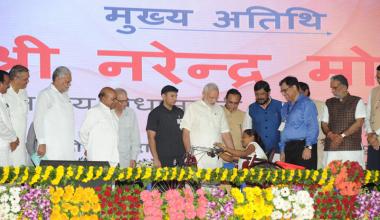 Shri Thaawarchand Gehlot, Minister for Social Justice and Empowerment launched the Beta version of ‘Divyang Sarathi’ - The accessible and comprehensive mobile application for easy dissemination of information to ‘Divyangjans’.
This mobile application is bound to empower the ‘Divyangjans’ by providing easier and convenient access of information to them as they can now understand all details pertaining to the schemes, scholarships, statutes, institutional support systems and other relevant and crucial information at the click of a button.
This mobile application aims at providing all relevant information pertaining to the Department of Empowerment of Persons with Disabilities (DEPwD), Ministry of Social Justice and Empowerment, including its various acts, rules, regulations and guidelines, schemes, information about the various outreach institutions, employment opportunities, and the disability market in an accessible format.
This application has been developed by the two Assistant Secretaries (Shri Anunaya Jha and Smt. B. Susheela) in the DEPwD.
Divyangjans: Know More Shri Thaawarchand Gehlot, Minister for Social Justice and Empowerment launched the Beta version of ‘Divyang Sarathi’ - The accessible and comprehensive mobile application for easy dissemination of information to ‘Divyangjans’.
This mobile application is bound to empower the ‘Divyangjans’ by providing easier and convenient access of information to them as they can now understand all details pertaining to the schemes, scholarships, statutes, institutional support systems and other relevant and crucial information at the click of a button.
This mobile application aims at providing all relevant information pertaining to the Department of Empowerment of Persons with Disabilities (DEPwD), Ministry of Social Justice and Empowerment, including its various acts, rules, regulations and guidelines, schemes, information about the various outreach institutions, employment opportunities, and the disability market in an accessible format.
This application has been developed by the two Assistant Secretaries (Shri Anunaya Jha and Smt. B. Susheela) in the DEPwD.
Divyangjans: Know More
- According to the Census 2011, there are over 2.68 crore ‘Divyangjans’ in India which constitute more than 2.2% of the population.
- The mobile application ‘Divyang Sarathi’ is compliant with the principles of UNCRPD for Universal Access and the provisions of the Rights of Persons with Disabilities Act, 2016.
- The Act mandates that all information to be made available in an accessible form.
- The application is also an integral part of the ICT component of the Accessible India Campaign launched by the Prime Minister Shri Narendra Modi on 3rd December, 2015.
Divyang Sarathi: Know More- The unique features of the mobile application ‘Divyang Sarathi’ are its audio notes (text-to-voice conversion software) embedded in the application which converts the written information into an audio file as well as the adjustable font size which can be altered as per the user’s requirement.
- The mobile application will certainly have a wide outreach as it has been developed bilingually i.e., the information is available in Hindi as well as English.
- The application has been so developed that once downloaded, it can be accessed by any Android smartphone User who may or may not have access to the internet. The mobile app will be available for download on Google Playstore.
|
▼ Meet INS Tarasa, India's latest water jet fast attack craft [09-27-17]
 MUMBAI: INS Tarasa, a Water Jet Fast Attack Craft intended for extended coastal and offshore surveillance and patrolling, was commissioned into the Indian Navy here on 26th Sept 2017.
Western Naval Command chief Vice Admiral Girish Luthra, commissioned the vessel.
The vessel, built in Kolkata, is of proven design with good endurance, low draught, high speed and manoeuvrability making her ideal for her primary role of extended coastal and offshore patrolling and surveillance.
Besides, the maiden voyage of the vessel from Kolkata to Mumbai in rough weather bore testimony to her seaworthiness.
It is the fourth and last of the Water Jet FACs built by Garden Reach Shipbuilders & Engineers, Kolkata.
The first two - INS Tarmugli and INS Tihayu - were commissioned in 2016 and are based in Vishakhapatnam, and the third, INS Tillanchang, was commissioned in March this year and is based in Karwar.
These ships are an upgrade of the Car Nicobar Class FACs of the Indian Navy, which were also indigenously designed and built by GRSE, Kolkata.
INS Tarasa: Know More MUMBAI: INS Tarasa, a Water Jet Fast Attack Craft intended for extended coastal and offshore surveillance and patrolling, was commissioned into the Indian Navy here on 26th Sept 2017.
Western Naval Command chief Vice Admiral Girish Luthra, commissioned the vessel.
The vessel, built in Kolkata, is of proven design with good endurance, low draught, high speed and manoeuvrability making her ideal for her primary role of extended coastal and offshore patrolling and surveillance.
Besides, the maiden voyage of the vessel from Kolkata to Mumbai in rough weather bore testimony to her seaworthiness.
It is the fourth and last of the Water Jet FACs built by Garden Reach Shipbuilders & Engineers, Kolkata.
The first two - INS Tarmugli and INS Tihayu - were commissioned in 2016 and are based in Vishakhapatnam, and the third, INS Tillanchang, was commissioned in March this year and is based in Karwar.
These ships are an upgrade of the Car Nicobar Class FACs of the Indian Navy, which were also indigenously designed and built by GRSE, Kolkata.
INS Tarasa: Know More
- INS Tarasa is 50 metres long, powered by three water jets which give it speed of over 35 knots (65 kmph), and is armed with a 30mm main gun and several light, medium and heavy machine guns.
- It is commanded by Lt Commander Praveen Kumar.
- Besides coastal and offshore surveillance, it is described as an ideal platform to render missions like EEZ Patrol, law enforcement, non-military missions like search and rescue, humanitarian assistance and disaster relief.
|
▼ Pt Deen Dayal Upadhayay Vigyan Gram Sankul Pariyojana, A DST initiative [09-25-17]
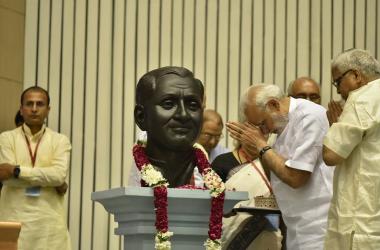 Department of Science and Technology is implementing several initiatives for upliftment and economic development of rural areas in the country.
A number of appropriate technologies have been developed, demonstrated and deployed at several locations in the country.
The Minister of Science & Technology, Earth Sciences and Environment, Forest & Climate Change, Dr. Harshvardhan launched “Pt Deen Dayal Upadhayay Vigyan Gram Sankul Pariyojana” which will experiment and endeavour to formulate and implement appropriate S&T Interventions for Sustainable Development through cluster approach in Uttarakhand.
This project has been inspired by teachings and ideals of Pt. Deen Dayal Upadhayay whose birth centenary is being celebrated this year.
DST has conceived to adopt a few clusters of villages in Uttarakhand and transform them to become self-sustainable in a time bound manner through the tools of Science and Technology (S&T).
The key deliverable in this approach is to utilise local resources and locally available skill sets and convert them in a manner using science and technology, that substantial value addition takes place in their local produce and services which can sustain the rural population locally.
Further, the local communities are not compelled to migrate from their native places in search of jobs and livelihoods.
Once this concept is validated in the few selected clusters, it can be replicated across large number of village clusters in the country.
Four clusters at Gaindikhata, Bazeera, Bhigun (in Garhwal) and Kausani (in Kumaon) have been selected for the intervention through a series of dialogues held among officials of DST and Uttarakhand State Council of Science and Technology (UCOST); Gramodaya Network, Surabhi Foundation and Uttarakhand Utthan Parishad; and other experts.
Intensive interaction with local population and field visits were carried out to identify the challenges and opportunities that exist in the clusters.
About a lakh of people would benefit directly or indirectly through this project in four identified clusters of 60 villages in Uttarakhand for pilot phase which are located at different altitudes (up to 3000 meters).
As the living conditions and resources available at different altitude is relatively different, the adopted strategy would help in creating models that are appropriate for different altitudes and could then be replicated in other hill states as well.
Areas of interventions in these selected clusters would be processing and value addition of milk, honey, mushroom, herbal tea, forest produce, horticulture and local crops, medicinal & aromatic plants and traditional craft and handloom of Uttarakhand.
Post-harvest processing of Kiwi, Strawberry, Cherry, Tulsi, Adrak, Badi Elaichi through solar drying technology, extraction of apricot oil using cold press technology.
Stringent product and process control interventions for energy and water conservation would also be ensured through this project.
Novel strategies for sustainable development in this ecologically fragile state are important.
Practice of agriculture, agro-based cottage industries and animal husbandry in an eco-friendly manner will be emphasized during the implementation of the project.
Sustainable employment and livelihood options within the clusters such as eco-tourism, naturopathy and yoga, are also planned to be promoted.
These clusters would act as model production cum training and demonstration centres.
There is a possibility of replicating this pilot phase initiative in other hill states of the country once it is established and stabilized.
Various scientific institutions would participate collectively in this endeavour to accomplish the dream of Pandit Deen Dayal Upadhyay towards ‘Swavlamban’.
Department of Science and Technology (DST) has committed INR 6.3 crore support for a period of three years for this project. Department of Science and Technology is implementing several initiatives for upliftment and economic development of rural areas in the country.
A number of appropriate technologies have been developed, demonstrated and deployed at several locations in the country.
The Minister of Science & Technology, Earth Sciences and Environment, Forest & Climate Change, Dr. Harshvardhan launched “Pt Deen Dayal Upadhayay Vigyan Gram Sankul Pariyojana” which will experiment and endeavour to formulate and implement appropriate S&T Interventions for Sustainable Development through cluster approach in Uttarakhand.
This project has been inspired by teachings and ideals of Pt. Deen Dayal Upadhayay whose birth centenary is being celebrated this year.
DST has conceived to adopt a few clusters of villages in Uttarakhand and transform them to become self-sustainable in a time bound manner through the tools of Science and Technology (S&T).
The key deliverable in this approach is to utilise local resources and locally available skill sets and convert them in a manner using science and technology, that substantial value addition takes place in their local produce and services which can sustain the rural population locally.
Further, the local communities are not compelled to migrate from their native places in search of jobs and livelihoods.
Once this concept is validated in the few selected clusters, it can be replicated across large number of village clusters in the country.
Four clusters at Gaindikhata, Bazeera, Bhigun (in Garhwal) and Kausani (in Kumaon) have been selected for the intervention through a series of dialogues held among officials of DST and Uttarakhand State Council of Science and Technology (UCOST); Gramodaya Network, Surabhi Foundation and Uttarakhand Utthan Parishad; and other experts.
Intensive interaction with local population and field visits were carried out to identify the challenges and opportunities that exist in the clusters.
About a lakh of people would benefit directly or indirectly through this project in four identified clusters of 60 villages in Uttarakhand for pilot phase which are located at different altitudes (up to 3000 meters).
As the living conditions and resources available at different altitude is relatively different, the adopted strategy would help in creating models that are appropriate for different altitudes and could then be replicated in other hill states as well.
Areas of interventions in these selected clusters would be processing and value addition of milk, honey, mushroom, herbal tea, forest produce, horticulture and local crops, medicinal & aromatic plants and traditional craft and handloom of Uttarakhand.
Post-harvest processing of Kiwi, Strawberry, Cherry, Tulsi, Adrak, Badi Elaichi through solar drying technology, extraction of apricot oil using cold press technology.
Stringent product and process control interventions for energy and water conservation would also be ensured through this project.
Novel strategies for sustainable development in this ecologically fragile state are important.
Practice of agriculture, agro-based cottage industries and animal husbandry in an eco-friendly manner will be emphasized during the implementation of the project.
Sustainable employment and livelihood options within the clusters such as eco-tourism, naturopathy and yoga, are also planned to be promoted.
These clusters would act as model production cum training and demonstration centres.
There is a possibility of replicating this pilot phase initiative in other hill states of the country once it is established and stabilized.
Various scientific institutions would participate collectively in this endeavour to accomplish the dream of Pandit Deen Dayal Upadhyay towards ‘Swavlamban’.
Department of Science and Technology (DST) has committed INR 6.3 crore support for a period of three years for this project.
|
▼ DST plans quantum computing revolution in India [09-22-17]
 Keen to tap into the next big advance in computing technology, the Department of Science and Technology (DST) is planning to fund a project to develop quantum computers.
A quantum computer, still largely a theoretical entity, employs the principles of quantum mechanics to store information in ‘qubits’ instead of the typical ‘bits’ of 1 and 0.
Qubits work faster because of the way such circuits are designed, and their promise is that they can do intensive number-crunching tasks much more efficiently than the fastest comparable computers.
For instance, to sort a billion numbers, a quantum computer would require 3.5 million fewer steps than a traditional machine, and would find the solution in only 31,623 steps, says a Morgan Stanley analysis.
Solving other problems, many having to do with computing physics, becomes possible on quantum machines, the authors say, whereas they might never be possible on traditional computers.
Experts from across the country are expected to gather this month in Allahabad for a workshop to develop such a computer.
Internationally, Canada’s D-Wave Systems, is a pioneer in developing quantum computers and has sold machines to Lockheed Martin and Google.
Experts, however, say that ‘true quantum computers’ are still years away, and existing systems use principles of quantum computing to solve very limited problems. Keen to tap into the next big advance in computing technology, the Department of Science and Technology (DST) is planning to fund a project to develop quantum computers.
A quantum computer, still largely a theoretical entity, employs the principles of quantum mechanics to store information in ‘qubits’ instead of the typical ‘bits’ of 1 and 0.
Qubits work faster because of the way such circuits are designed, and their promise is that they can do intensive number-crunching tasks much more efficiently than the fastest comparable computers.
For instance, to sort a billion numbers, a quantum computer would require 3.5 million fewer steps than a traditional machine, and would find the solution in only 31,623 steps, says a Morgan Stanley analysis.
Solving other problems, many having to do with computing physics, becomes possible on quantum machines, the authors say, whereas they might never be possible on traditional computers.
Experts from across the country are expected to gather this month in Allahabad for a workshop to develop such a computer.
Internationally, Canada’s D-Wave Systems, is a pioneer in developing quantum computers and has sold machines to Lockheed Martin and Google.
Experts, however, say that ‘true quantum computers’ are still years away, and existing systems use principles of quantum computing to solve very limited problems.
|
▼ Scientists discover asteroids orbiting each other! [09-22-17]
 An unusual object, discovered in the solar system’s asteroid belt, is actually two asteroids orbiting each other, scientists including one of Indian origin have found using the Hubble Space Telescope.
The object has comet-like features including a bright halo of material, called a coma, and a long tail of dust.
Hubble was used to image the asteroid, designated 300163 (2006 VW139), in September 2016 just before the asteroid made its closest approach to the Sun.
The images revealed that it was actually not one, but two asteroids of almost the same mass and size, orbiting each other at a distance of 96 kilometres.
Asteroid 300163 (2006 VW139) was discovered by Spacewatch in November 2006 and then the possible cometary activity was seen in November 2011 by Pan - STARRS.
Both Spacewatch and Pan-STARRS are asteroid survey projects of NASA’s Near Earth Object Observations Program.
After the Pan-STARRS observations it was also given a comet designation of 288P.
This makes the object the first known binary asteroid that is also classified as a main-belt comet.
The more recent Hubble observations revealed ongoing activity in the binary system.
The combined features of the binary asteroid - wide separation, near-equal component size, high eccentricity orbit, and comet - like activity- also make it unique among the few known binary asteroids that have a wide separation.
Understanding its origin and evolution may provide new insights into the early days of the solar system.
Main-belt comets may help to answer how water came to a bone-dry Earth billions of years ago.
Binary Asteroid System: Know More An unusual object, discovered in the solar system’s asteroid belt, is actually two asteroids orbiting each other, scientists including one of Indian origin have found using the Hubble Space Telescope.
The object has comet-like features including a bright halo of material, called a coma, and a long tail of dust.
Hubble was used to image the asteroid, designated 300163 (2006 VW139), in September 2016 just before the asteroid made its closest approach to the Sun.
The images revealed that it was actually not one, but two asteroids of almost the same mass and size, orbiting each other at a distance of 96 kilometres.
Asteroid 300163 (2006 VW139) was discovered by Spacewatch in November 2006 and then the possible cometary activity was seen in November 2011 by Pan - STARRS.
Both Spacewatch and Pan-STARRS are asteroid survey projects of NASA’s Near Earth Object Observations Program.
After the Pan-STARRS observations it was also given a comet designation of 288P.
This makes the object the first known binary asteroid that is also classified as a main-belt comet.
The more recent Hubble observations revealed ongoing activity in the binary system.
The combined features of the binary asteroid - wide separation, near-equal component size, high eccentricity orbit, and comet - like activity- also make it unique among the few known binary asteroids that have a wide separation.
Understanding its origin and evolution may provide new insights into the early days of the solar system.
Main-belt comets may help to answer how water came to a bone-dry Earth billions of years ago.
Binary Asteroid System: Know More
- The team estimates that 2006 VW139/288P has existed as a binary system only for about 5,000 years. The most probable formation scenario is a breakup due to fast rotation.
- After that, the two fragments may have been moved further apart by the effects of ice sublimation, which would give a tiny push to an asteroid in one direction as water molecules are ejected in the other direction.
- The fact that 2006 VW139/288P is so different from all other known binary asteroids raises some questions about how common such systems are in the asteroid belt.
- We need more theoretical and observational work, as well as more objects similar to this object, to find an answer to this question.
|
▼ Now, cement technology to reduce CO2 emissions! [09-22-17]
 A research collaboration between India and Switzerland on a new cement material that can reduce carbon dioxide emissions in the manufacturing process is set to take off into implementation.
The construction sector is a major contributor to global carbon dioxide emissions.
Though this is known, it appears difficult to reduce the scale of construction, especially as it is a route to establishing more equitable conditions in developing countries like India.
One way of mitigating the emissions factor is the use of Limestone Calcined Clay Cement or the LC3 technology.
Traditional processes that manufacture cement from clinker-limestone or clinker-calcined clay combinations are well known.
LC3 effects a synergy between these processes. The combination of the new method and the material properties effectively reduces carbon dioxide emissions by 30% as compared to the traditional way of manufacturing cement.
How It Works A research collaboration between India and Switzerland on a new cement material that can reduce carbon dioxide emissions in the manufacturing process is set to take off into implementation.
The construction sector is a major contributor to global carbon dioxide emissions.
Though this is known, it appears difficult to reduce the scale of construction, especially as it is a route to establishing more equitable conditions in developing countries like India.
One way of mitigating the emissions factor is the use of Limestone Calcined Clay Cement or the LC3 technology.
Traditional processes that manufacture cement from clinker-limestone or clinker-calcined clay combinations are well known.
LC3 effects a synergy between these processes. The combination of the new method and the material properties effectively reduces carbon dioxide emissions by 30% as compared to the traditional way of manufacturing cement.
How It Works
- In manufacturing Portland cement, limestone and materials like clay are heated together in huge kilns to high temperatures (approximately 1,450 degrees C), so that they fuse without melting to give clinker.
- This is the most CO2-intensive part of the whole process.
- The carbon dioxide comes both from the burning of the fuel needed to create that temperature and due to the breakdown of limestone into calcium oxide and carbon dioxide.
The latter part accounts for 60% of the CO2 emissions in manufacture of cement.
- The best thing to do would be to substitute CO2-intensive clinker with a different material.
In India, fly ash - a waste produced in the burning of coal for producing energy - is used in the manufacture of blended cement.
- However this is used in a lower proportions and only where available; therefore, for effectively reducing emissions, more clinker is to be substituted with calcined clay and limestone.
- This reduces emissions by 30% with respect to Portland cement.
- There is an added advantage to the new material when used in coastal areas where reinforced concrete can be damaged by chloride diffusing through the material.
- The new cement has less porosity and it is more difficult for the chloride to get in and damage the steel rods.
- This gives the new cement a longer service life.
|
▼ Now, a Boat Lab for River Brahmaputra! [09-21-17]
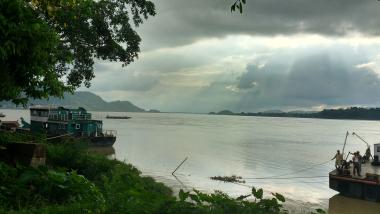 Soon, it will be possible to cruise along the Brahmaputra along while doing some serious science.
The Department of Biotechnology will commission a two-tiered barge that will roughly be the size of two large conference rooms and host scientists and a full-fledged lab.
This will allow those on board to collect samples from various stretches of the river, perform tests on water quality and biodiversity of the wider ecosystem.
The proposed vessel, now only known as the Brahmaputra Biodiversity Biology Boat (B4), would also be linked to smaller boats and research labs.
The first experiments will likely begin this December and will have the boat - a re-purposed one - trawl Pasighat, Dibrigarh, Neemati, Tejpur and Guwahati in Assam and managed by the Indian Institute of Technology, Guwahati.
The “B4” will also have a teaching laboratory for school and college children.
Specifying that this wouldn’t be just a show boat, officials indicated there would also be ‘mobile labs’ that would run along the tributaries of the Brahmaputra to feed in data to the B4.
For a river of the size and diversity of the Brahmaputra, there is very little research done to understand its hydrology, water quality and biodiversity.
A boat of this nature would be one of its kind in the world though there were a few precedents in China and mobile laboratories that studied the Amazon river.
Government aimed to spend ₹200 crore across a range of programmes. Soon, it will be possible to cruise along the Brahmaputra along while doing some serious science.
The Department of Biotechnology will commission a two-tiered barge that will roughly be the size of two large conference rooms and host scientists and a full-fledged lab.
This will allow those on board to collect samples from various stretches of the river, perform tests on water quality and biodiversity of the wider ecosystem.
The proposed vessel, now only known as the Brahmaputra Biodiversity Biology Boat (B4), would also be linked to smaller boats and research labs.
The first experiments will likely begin this December and will have the boat - a re-purposed one - trawl Pasighat, Dibrigarh, Neemati, Tejpur and Guwahati in Assam and managed by the Indian Institute of Technology, Guwahati.
The “B4” will also have a teaching laboratory for school and college children.
Specifying that this wouldn’t be just a show boat, officials indicated there would also be ‘mobile labs’ that would run along the tributaries of the Brahmaputra to feed in data to the B4.
For a river of the size and diversity of the Brahmaputra, there is very little research done to understand its hydrology, water quality and biodiversity.
A boat of this nature would be one of its kind in the world though there were a few precedents in China and mobile laboratories that studied the Amazon river.
Government aimed to spend ₹200 crore across a range of programmes.
|
▼ Mars had water 3.5 billion years ago! [09-20-17]
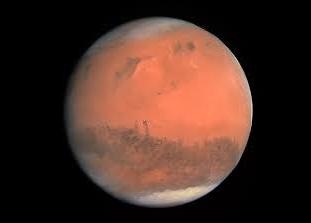 Mars had a surface environment that supported liquid water about 3.5 billion years ago, according to a study of river deposits spread across the red planet.
A region of Mars named Aeolis Dorsa contains some of the most spectacular and densely packed river deposits seen on the planet, researchers said.
These deposits are observable with satellite images because they have undergone a process called “topographic inversion,” where the deposits filling once topographically low river channels have been exhumed in such a way that they now exist as ridges at the surface of the planet, they said.
With the use of high-resolution images and topographic data from cameras on orbiting satellites, researchers identified fluvial deposit stacking patterns and changes in sedimentation styles controlled by a migratory coastline.
They also developed a method to measure river paleo-transport direction for a subset of these ridges.
Together, these measurements demonstrate that the studied river deposits once filled incised valleys. On Earth, incised valleys are commonly cut and filled during falling and rising eustatic sea level, respectively.
Cardenas and colleagues conclude that similar falling and rising water levels in a large water body forced the formation of the paleo-valleys in their study area.
Cross-cutting relationships are observed at the valley-scale, indicating multiple episodes of water level fall and rise, each well over 50 metres, a similar scale to eustatic sea level changes on Earth, researchers said.
The conclusion that such large water level fluctuations and coastline movements were recorded by these river deposits suggests some long-term stability in the controlling, downstream water body, which would not be expected from catastrophic hydrologic events. Mars had a surface environment that supported liquid water about 3.5 billion years ago, according to a study of river deposits spread across the red planet.
A region of Mars named Aeolis Dorsa contains some of the most spectacular and densely packed river deposits seen on the planet, researchers said.
These deposits are observable with satellite images because they have undergone a process called “topographic inversion,” where the deposits filling once topographically low river channels have been exhumed in such a way that they now exist as ridges at the surface of the planet, they said.
With the use of high-resolution images and topographic data from cameras on orbiting satellites, researchers identified fluvial deposit stacking patterns and changes in sedimentation styles controlled by a migratory coastline.
They also developed a method to measure river paleo-transport direction for a subset of these ridges.
Together, these measurements demonstrate that the studied river deposits once filled incised valleys. On Earth, incised valleys are commonly cut and filled during falling and rising eustatic sea level, respectively.
Cardenas and colleagues conclude that similar falling and rising water levels in a large water body forced the formation of the paleo-valleys in their study area.
Cross-cutting relationships are observed at the valley-scale, indicating multiple episodes of water level fall and rise, each well over 50 metres, a similar scale to eustatic sea level changes on Earth, researchers said.
The conclusion that such large water level fluctuations and coastline movements were recorded by these river deposits suggests some long-term stability in the controlling, downstream water body, which would not be expected from catastrophic hydrologic events.
|
▼ Rapidly rotating stars emit polarised light – Indian prediction found correct! [09-20-17]
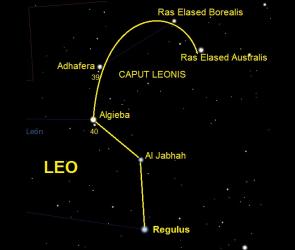 Over 70 years after Indian astrophysicist and Nobel laureate Subrahmanyan Chandrasekhar predicted that rapidly rotating stars would emit polarised light, scientists in Australia have observed the phenomenon for the first time.
Researchers used a highly sensitive piece of equipment to detect the polarised light from Regulus, one of the brightest stars in the night sky.
The equipment provided unprecedented insights into the star, which is in the constellation Leo, allowing the scientists to determine its rate of spinning and the orientation in space of the star’s spin axis.
Regulus is rotating so quickly it is close to flying apart, with a spin rate of 96.5 per cent of the angular velocity for break-up.
It is spinning at approximately 320 kilometres per second - equivalent to travelling from Sydney to Canberra in less than a second.
Chandrashekar's Prediction: Know More Over 70 years after Indian astrophysicist and Nobel laureate Subrahmanyan Chandrasekhar predicted that rapidly rotating stars would emit polarised light, scientists in Australia have observed the phenomenon for the first time.
Researchers used a highly sensitive piece of equipment to detect the polarised light from Regulus, one of the brightest stars in the night sky.
The equipment provided unprecedented insights into the star, which is in the constellation Leo, allowing the scientists to determine its rate of spinning and the orientation in space of the star’s spin axis.
Regulus is rotating so quickly it is close to flying apart, with a spin rate of 96.5 per cent of the angular velocity for break-up.
It is spinning at approximately 320 kilometres per second - equivalent to travelling from Sydney to Canberra in less than a second.
Chandrashekar's Prediction: Know More
- In 1946, Chandrasekhar had predicted the emission of polarised light from the edges of stars, prompting the development of sensitive instruments called stellar polarimeters to try to detect this effect.
- Optical polarisation is a measure of the orientation of the oscillations of a light beam to its direction of travel.
- In 1968, other researchers built on Chandrasekhar’s work to predict that the distorted, or squashed, shape of a rapidly rotating star would lead to the emission of polarised light, but its detection has eluded astronomers until now.
- The instrument built, the High Precision Polarimetric Instrument (HIPPI) is the world’s most sensitive astronomical polarimeter.
- Its high precision has allowed scientists to detect polarised light from a rapidly spinning star for the first time
- It has previously been extremely difficult to measure these properties of rapidly rotating stars, researchers said.
- Yet the information is crucial for understanding the life cycles of most of the hottest and largest stars in the galaxies, which are the ones that produce the heaviest elements, such as iron and nickel, in interstellar space.
Regulus: Know More- Regulus is about 79 light years away.
- Regulus, also designated Alpha Leonis, is the brightest star in the constellation of Leo and one of the brightest stars in the night sky, lying approximately 79 light years from the Sun.
- Constellation: Leo
- B - V color index: –0.11/+0.86
- U - B color index: –0.36/+0.51
- Apparent magnitude (V): 1.40/8.13/13.50
- Absolute magnitude (MV): –0.52/6.3/11.6
- Age: ≳ Polarised light emitted by 1 Gyr
- During the total solar eclipse in the US in August, Regulus was just one degree away from the Sun.
- It was, to many people, the only star visible during the eclipse.
|
▼ Meet Tez : Google's payment app operating through sound [09-19-17]
 On 18th Sept 2017, Finance Minister Arun Jaitley launched Google’s payment app - ‘Tez’.
Tez by Google is perhaps the simplest form of monetary transactions.
Tez by Google and other ecosystems will make a major change in the digital payments landscape in India.
The tech giant claimed that Tez will enable money transfer directly from the bank accounts of customers, without them having to share their ‘personal information’.
The app will function on both Android and iOS platforms.
Google also said that the app will ‘understand’ eight Indian languages and will work with 55 banks
Tez (which means “Fast” in Hindi is Google’s play to replace cash transactions and become a more central part of how people pay for things, using their mobile to do so.
But it’s also a chance for the company to push out some new technologies - like audio QR (AQR), which lets users transfer money by letting their phones speak to each other with sounds - to see how it can make that process more frictionless, and therefore more attractive to use than cash itself.
Tez will see Google linking up with several major banks in the country by way of UPI (Unified Payments Interface) - a payment standard and system backed by the government in its push to bring more integrated banking services into a very fragmented market.
There will also be phones coming to the market from Lava, Micromax, Nokia and Panasonic with Tez preloaded, the company said.
Google has confirmed to me that payments made and taken using UPI are free for consumers and small merchants
To be clear, Tez is not a mobile “wallet” in the same way as PayTM offers a mobile wallet, where money is stored in the app and needs to be topped up to be used;
It’s more like Apple’s Wallet or other mobile wallets in the west: a place that links up your phone with your bank accounts to let you use your phone as a way to deduct payments from those accounts.
Supported banks include Axis, HDFC Bank, ICICI and State Bank of India and others that support UPI.
Online payment partners include large food chains like Dominos, transport services like RedBus, and Jet Airways
The app has support for English, Hindi, Bengali, Gujarati, Kannada, Marathi, Tamil, and Telugu.
For money transfers, there is a limit of ₹1,00,000 in one day across all UPI apps, and 20 transfers in one day.
AQR and Tez: Know More On 18th Sept 2017, Finance Minister Arun Jaitley launched Google’s payment app - ‘Tez’.
Tez by Google is perhaps the simplest form of monetary transactions.
Tez by Google and other ecosystems will make a major change in the digital payments landscape in India.
The tech giant claimed that Tez will enable money transfer directly from the bank accounts of customers, without them having to share their ‘personal information’.
The app will function on both Android and iOS platforms.
Google also said that the app will ‘understand’ eight Indian languages and will work with 55 banks
Tez (which means “Fast” in Hindi is Google’s play to replace cash transactions and become a more central part of how people pay for things, using their mobile to do so.
But it’s also a chance for the company to push out some new technologies - like audio QR (AQR), which lets users transfer money by letting their phones speak to each other with sounds - to see how it can make that process more frictionless, and therefore more attractive to use than cash itself.
Tez will see Google linking up with several major banks in the country by way of UPI (Unified Payments Interface) - a payment standard and system backed by the government in its push to bring more integrated banking services into a very fragmented market.
There will also be phones coming to the market from Lava, Micromax, Nokia and Panasonic with Tez preloaded, the company said.
Google has confirmed to me that payments made and taken using UPI are free for consumers and small merchants
To be clear, Tez is not a mobile “wallet” in the same way as PayTM offers a mobile wallet, where money is stored in the app and needs to be topped up to be used;
It’s more like Apple’s Wallet or other mobile wallets in the west: a place that links up your phone with your bank accounts to let you use your phone as a way to deduct payments from those accounts.
Supported banks include Axis, HDFC Bank, ICICI and State Bank of India and others that support UPI.
Online payment partners include large food chains like Dominos, transport services like RedBus, and Jet Airways
The app has support for English, Hindi, Bengali, Gujarati, Kannada, Marathi, Tamil, and Telugu.
For money transfers, there is a limit of ₹1,00,000 in one day across all UPI apps, and 20 transfers in one day.
AQR and Tez: Know More
- Google says that AQR - the sound-based format for transferring money securely between devices - is its own proprietary technology.
- This appears to be the first time that Google has used it for payments, although it has used ultrasonic sound for transferring information between devices before
- For example, the tech has been used in Chromecast to connect devices since 2014. Other startups that have used audio-based “codes” to transfer payments and other data before include Lisnr, and Chirp.
- While AQR might seem like a neat technical twist, there are some practical reasons behind why Google might opt for this in Tez.
- For starters, it obviates the need for NFC in the device, and in the payment devices of merchants or whoever else a person is planning to transact with.
- The other thing is that it makes any kind of contactless transaction with the device fairly flexible and easy.
- Services like Airdrop on iPhones require Bluetooth and if you’ve used it before isn’t that seamless and foolproof to turn on (even though it works like a charm when it does). QR codes, meanwhile, require you to turn on the camera on your device and physically align it with a code on another screen, a potentially fiddly and difficult process.
- Using audio taps into some of the most basic features on even the most basic phones, a speaker and a microphone.
- Google has also trademarked the name in other Asian countries like Indonesia and the Philippines, so there seems to be a wider strategy to expand this to other regions.
- India, the second-most populated country in Asia after China, is a ripe market for mobile payment services, with a rapidly expanding middle class with more disposable income and a wider population that is very tech-focussed, with an estimated 300 million smartphones in use today.
- Digital payments are expected to reach a volume of $500 billion annually by 2020, according to a report from BCG and Google.
|
▼ Giant triton snail that eats starfish to save Great Barrier Reef! [09-19-17]
 A giant starfish-eating snail could be unleashed to help save the Great Barrier Reef, officials said with a trial under way to breed thousands of the rare species.
Predatory crown-of-thorns starfish, which munch coral, are naturally-occurring but have proliferated due to pollution and run-off at the struggling World Heritage-listed ecosystem.
Their impact has been profound with a major study of the 2,300-km long reef’s health in 2012 showing coral cover halved over the past 27 years, with 42% of the damage attributed to the pest.
Now, Australian Institute of Marine Science (AIMS) research has shown they avoid areas where the Pacific triton sea snail - also known as the giant triton - is present.
The snails, which can grow to half a metre, have a well developed sense of smell and can hunt their prey by scent alone.
Research showed they were particularly fond of crown-of-thorns, but only eat a few each week, and with the snail almost hunted to extinction for their shells, there are not many left.
This led the government to announce funding to research breeding them.
The possibilities the triton breeding project opens up are exciting.
If successful, this research will allow scientists to closely look at the impact of giant tritons on crown-of-thorns behaviour and test their potential as a management tool to help reduce coral lost to outbreaks.
Giant tritons held at AIMS have laid numerous egg capsules. But they are so rare, almost nothing is known about their life cycle. A giant starfish-eating snail could be unleashed to help save the Great Barrier Reef, officials said with a trial under way to breed thousands of the rare species.
Predatory crown-of-thorns starfish, which munch coral, are naturally-occurring but have proliferated due to pollution and run-off at the struggling World Heritage-listed ecosystem.
Their impact has been profound with a major study of the 2,300-km long reef’s health in 2012 showing coral cover halved over the past 27 years, with 42% of the damage attributed to the pest.
Now, Australian Institute of Marine Science (AIMS) research has shown they avoid areas where the Pacific triton sea snail - also known as the giant triton - is present.
The snails, which can grow to half a metre, have a well developed sense of smell and can hunt their prey by scent alone.
Research showed they were particularly fond of crown-of-thorns, but only eat a few each week, and with the snail almost hunted to extinction for their shells, there are not many left.
This led the government to announce funding to research breeding them.
The possibilities the triton breeding project opens up are exciting.
If successful, this research will allow scientists to closely look at the impact of giant tritons on crown-of-thorns behaviour and test their potential as a management tool to help reduce coral lost to outbreaks.
Giant tritons held at AIMS have laid numerous egg capsules. But they are so rare, almost nothing is known about their life cycle.
|
▼ Planet 9 at the edge of our solar system: Know More [09-18-17]
 'Planet 9' - an unseen planet on the edge of our solar system - probably formed closer to home around the Sun than previously thought, astronomers say.
Researchers in the UK found that Planet 9 is unlikely to have been captured from another planetary system, as has previously been suggested.
The outskirts of the solar system have always been something of an enigma, with astronomers in the late 19th and early 20th centuries searching for a giant planet that was not there, and the subsequent discovery of Pluto in 1930.
Pluto was downgraded in status to a 'dwarf planet' because astronomers discovered many other small objects so-called Edgeworth-Kuiper Belt objects at similar distances from the Sun.
Last year, astronomers working in the US postulated the presence of 'Planet 9' to explain the strange orbital properties of some Edgeworth-Kuiper Belt objects.
However, while it is not possible to directly observe Planet 9, it has not stopped theorists from trying to work out how it got there.
Planet 9: Know More 'Planet 9' - an unseen planet on the edge of our solar system - probably formed closer to home around the Sun than previously thought, astronomers say.
Researchers in the UK found that Planet 9 is unlikely to have been captured from another planetary system, as has previously been suggested.
The outskirts of the solar system have always been something of an enigma, with astronomers in the late 19th and early 20th centuries searching for a giant planet that was not there, and the subsequent discovery of Pluto in 1930.
Pluto was downgraded in status to a 'dwarf planet' because astronomers discovered many other small objects so-called Edgeworth-Kuiper Belt objects at similar distances from the Sun.
Last year, astronomers working in the US postulated the presence of 'Planet 9' to explain the strange orbital properties of some Edgeworth-Kuiper Belt objects.
However, while it is not possible to directly observe Planet 9, it has not stopped theorists from trying to work out how it got there.
Planet 9: Know More
- Planet 9 is at least ten times bigger than Earth, making it unlikely that it formed at such a large distance from the Sun.
- Instead, it has been suggested it either moved there from the inner regions of the Solar System, or it could have been captured when the Sun was still in its birth star cluster.
- Researchers simulated the Sun's stellar nursery where interactions are common and found that even in conditions optimised to capture free-floating planets, only five-to-10 out of 10,000 planets are captured onto an orbit like Planet 9's.
|
▼ Venus's dark side revealed! [09-18-17]
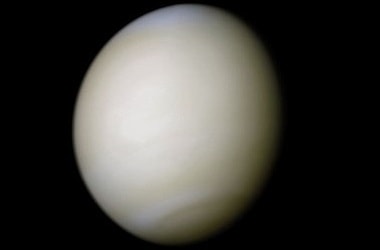 Scientists have characterised wind and cloud patterns of the night side of planet Venus for the first time, and found that it behaves very differently from the part facing the Sun.
The night side exhibits unexpected and previously-unseen cloud types, morphologies, and dynamics - some of which appear to be connected to features on the planet's surface.
This is the first time humans have been able to characterise how the atmosphere circulates on the night side of Venus on a global scale.
Scientists found that the cloud patterns there are different to those on the dayside, and influenced by Venus' topography on the dark side.
Venus' atmosphere is dominated by strong winds that whirl around the planet far faster than Venus itself rotates.
This phenomenon, known as 'super-rotation', sees Venusian winds rotating up to 60 times faster than the planet below, pushing and dragging along clouds within the atmosphere as they go.
These clouds travel fastest at the upper cloud level, some 65 to 72 kilometres above the surface.
The team used the Visible and Infrared Thermal Imaging Spectrometer (VIRTIS) on European Space Agency (ESA)'s Venus Express spacecraft to observe the clouds in the infrared.
VIRTIS enabled scientists to see these clouds properly for the first time, allowing them to explore what previous teams could not and we discovered unexpected and surprising results.
Rather than capturing single images, VIRTIS gathered a 'cube' of hundreds of images of Venus acquired simultaneously at different wavelengths.
This allowed the team to combine numerous images to improve the visibility of the clouds, and see them at unprecedented quality.
The VIRTIS images thus reveal phenomena on Venus' night side that have never before been seen on the dayside. Scientists have characterised wind and cloud patterns of the night side of planet Venus for the first time, and found that it behaves very differently from the part facing the Sun.
The night side exhibits unexpected and previously-unseen cloud types, morphologies, and dynamics - some of which appear to be connected to features on the planet's surface.
This is the first time humans have been able to characterise how the atmosphere circulates on the night side of Venus on a global scale.
Scientists found that the cloud patterns there are different to those on the dayside, and influenced by Venus' topography on the dark side.
Venus' atmosphere is dominated by strong winds that whirl around the planet far faster than Venus itself rotates.
This phenomenon, known as 'super-rotation', sees Venusian winds rotating up to 60 times faster than the planet below, pushing and dragging along clouds within the atmosphere as they go.
These clouds travel fastest at the upper cloud level, some 65 to 72 kilometres above the surface.
The team used the Visible and Infrared Thermal Imaging Spectrometer (VIRTIS) on European Space Agency (ESA)'s Venus Express spacecraft to observe the clouds in the infrared.
VIRTIS enabled scientists to see these clouds properly for the first time, allowing them to explore what previous teams could not and we discovered unexpected and surprising results.
Rather than capturing single images, VIRTIS gathered a 'cube' of hundreds of images of Venus acquired simultaneously at different wavelengths.
This allowed the team to combine numerous images to improve the visibility of the clouds, and see them at unprecedented quality.
The VIRTIS images thus reveal phenomena on Venus' night side that have never before been seen on the dayside.
|
▼ Shinkansen Splendour: India gets first bullet train [09-15-17]
Prime Minister Narendra Modi and his Japanese counterpart Shinzo Abe laid the foundation stone for India’s first bullet train project in Ahmedabad on Sept 14, 2017.
The government has said the bullet train technology will revolutionise and transform the railways.
Critics, however, say the funds for the bullet train project could have been better utilised to revamp the ailing Indian Railways, which has witnessed various setbacks in the form of derailments and accidents in the past.
The train will have a top speeds of 320-350 km per hour and it is expected to reduce travel time between the two cities to around 2 hours from the existing 7-8 hours. The fares could be in the range of INR 3000 - 5,000.
Passengers will have two speed options in trains: - High-speed: It will take 2.58 hours to reach the destination
- Rapid high-speed: It will cover the distance in 2.07 hours.
Initially, each high speed train will have 10 cars and the capacity to accommodate 750 people.
It will increase to 16 cars that will accommodate 1,200 people.
According to initial estimates, around 1.6 crore people are expected to travel by the bullet train annually. By 2050, around 1.6 lakh commuters should travel by the high-speed train on a daily basis
On the Ahmedabad-Mumbai route, 12 stations have been proposed: Mumbai, Thane, Virar, Boisar, Vapi, Bilimora, Surat, Bharuch, Vadodara, Anand, Ahmedabad and Sabarmati.
The railways will only require around 825 hectares of land for the project as 92% of the route will be elevated, six per cent will go through tunnels and only the remaining two per cent will be on the ground. India’s longest tunnel21-km-long - will be dug between Boisar and BKC in Mumbai, 7km of which will be under the sea.
The train tracks will elevated to 18 metres for most of its route to ensure the train runs over the existing railway route.
The remaining, less than 40km, stretch will be under sea between Thane and Vasai, and underground in Mumbai.
The 508km-long Mumbai to Ahmedabad High Speed Rail (MAHSR) is scheduled for completion in December 2023, but commencement date has been sought to be advanced to August 2022.
The government said it will create around 15 lakh new jobs in India.
A dedicated High Speed Rail Training Institute will train about 4,000 technical staff of the bullet train project, The Indian Express report said.
Second Project: India's Bullet Train- The Indian Railways will launch the country’s second high-speed train from Delhi to Amritsar via Chandigarh.
- The train will run on standard broad gauge and the project shall be completed by 2024. The proposed train will cover the 458-km-long route in 2 hours and 30 minutes running at a speed of 300-350 kmph, reducing the travel time between New Delhi and Amritsar by about two and a half hours.
- Proposed stops will be Ambala, Chandigarh, Ludhiana, Jalandhar. The fare will be fixed equivalent to that of Shatabdi’s AC executive class
- Shinkansen, meaning ‘new trunk line’, are trains shaped like bullets that run at the speed of 320 kmph.
- They have become a symbol of the country’s progress and technological advancements after the World War 2.
- Shinkansen have a reputation for punctuality and safety. The trains have never been in any accident since 1964, when they were introduced.
|
▼ First compendium of Sundarbans animals by ZSI [09-14-17]
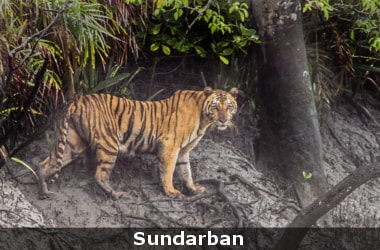 In a first, the Zoological Survey of India (ZSI) has published a compendium of animal species in the Indian Sundarbans, estimating that there are 2,626 of them in the fragile island ecosystem.
The listing includes a diverse 25 phyla, as they are biologically classified.
The Indian segment of the Sundarbans, part of a UNESCO World Heritage site, forms part of the Ganga-Brahmaputra delta across 9,630 sq. km, distributed among 104 islands.
The region hosts 2,487 species that come under the zoological kingdom of Animalia, and 140 under the more primitive Protista.
The publication titled Fauna of Sundarban Biosphere Reserve is the first consolidated and updated information of the faunal diversity of the Sundarbans.
It lists over 2,600 species, including the new species described from the mangrove ecosystem as well as threats faced by them due to climate change.
When we talk about Sundarbans we refer to only a few major species in the reserve forest area in about 4,260 sq. km.
The publication catalogues the entire faunal diversity of Sundarban Biosphere Reserve covering 9,630 sq. km spread over 19 blocks in South 24 Parganas and North 24 Parganas of West Bengal.
The researchers document the famous tigers of these islands, which have adapted to aquatic conditions around, the human-tiger conflict, and behaviour of the big cat.
The fortunes of 50 mammalian species including the Asian small-clawed Otter, Gangetic Dolphin, Grey and Marsh Mongoose and the wild Rhesus Monkey, the only primate here, are also documented.
Two Rhinos, Swamp deer, Barking deer and Hog deer and Asiatic Wild Water Buffalo are not found in Sundarbans anymore.
Other Species in Sunderbans: Know More In a first, the Zoological Survey of India (ZSI) has published a compendium of animal species in the Indian Sundarbans, estimating that there are 2,626 of them in the fragile island ecosystem.
The listing includes a diverse 25 phyla, as they are biologically classified.
The Indian segment of the Sundarbans, part of a UNESCO World Heritage site, forms part of the Ganga-Brahmaputra delta across 9,630 sq. km, distributed among 104 islands.
The region hosts 2,487 species that come under the zoological kingdom of Animalia, and 140 under the more primitive Protista.
The publication titled Fauna of Sundarban Biosphere Reserve is the first consolidated and updated information of the faunal diversity of the Sundarbans.
It lists over 2,600 species, including the new species described from the mangrove ecosystem as well as threats faced by them due to climate change.
When we talk about Sundarbans we refer to only a few major species in the reserve forest area in about 4,260 sq. km.
The publication catalogues the entire faunal diversity of Sundarban Biosphere Reserve covering 9,630 sq. km spread over 19 blocks in South 24 Parganas and North 24 Parganas of West Bengal.
The researchers document the famous tigers of these islands, which have adapted to aquatic conditions around, the human-tiger conflict, and behaviour of the big cat.
The fortunes of 50 mammalian species including the Asian small-clawed Otter, Gangetic Dolphin, Grey and Marsh Mongoose and the wild Rhesus Monkey, the only primate here, are also documented.
Two Rhinos, Swamp deer, Barking deer and Hog deer and Asiatic Wild Water Buffalo are not found in Sundarbans anymore.
Other Species in Sunderbans: Know More
- There are 356 species of birds, the most spectacular being raptors, or birds of prey, that occupy the highest canopies of the forest.
- Osprey, Brahminy Kite and White-Bellied Sea Eagle are dominant, while Rose-ringed parakeets, flycatchers and warblers are also found in the middle tier, while in the lower tier, kingfishers abound - and the Sundarbans has nine of them.
- There are 11 turtles, including the famous Olive Ridley and Hawskbill sea turtles and the most threatened freshwater species, the River Terrapin.
- A crocodile, 13 lizards including three species of Monitor Lizards and five Geckos are found here. The rivers, creeks channels and the islands together harbour about 30 snake species, led by the King Cobra, considered vulnerable by IUCN.
- Others documented are the Monocellate or monocled cobra, Russell’s viper, common and banded kraits. Besides, ten species of frogs and toads are found
- The mangrove ecosystem covers about 350 species of fish. Cartilaginous fish, which have skeletons of cartilage rather than bone, make up 10.3%.
- The IUCN conservation status shows 6.3% fish are near-threatened and 4.85% are threatened. Also, there are 173 mollusks.
- In another indication of its richness, 753 insect species are encountered in the Sundarbans Biosphere Reserve. Of these, 210 are butterflies and moths. Moreover, Crustaceans - crabs, shrimp and prawns - constitute 334 species.
|
▼ Google Translate launches new avatar [09-14-17]
 Google on Sept 12, 2017 unveiled several updates to its Translate App in an effort to bring down language barriers.
It said users in Tamil, Kannada, Telugu, Urdu, Bengali, Gujarati and Marathi can experience offline translations and instant visual translation in their preferred language.
The biggest application is that they are breaking language barriers.
Google Translate has also added support for conversation mode in regional languages including Tamil and Bengali.
This feature lets users have a bilingual conversation with someone, simply by talking to the Google Translate app.
Google Translate: Know More Google on Sept 12, 2017 unveiled several updates to its Translate App in an effort to bring down language barriers.
It said users in Tamil, Kannada, Telugu, Urdu, Bengali, Gujarati and Marathi can experience offline translations and instant visual translation in their preferred language.
The biggest application is that they are breaking language barriers.
Google Translate has also added support for conversation mode in regional languages including Tamil and Bengali.
This feature lets users have a bilingual conversation with someone, simply by talking to the Google Translate app.
Google Translate: Know More
- India is among the top four countries globally using Google Translate which translates over 140 billion words every day.
- More than 400 million people in India used the Internet.
- But the vast majority of India’s online content is in English, which only 20% of the country’s population speaks.
- The Translate app already lets the user use camera mode to snap a photo of English text and get a translation for it in these languages.
- Now, with Word Lens feature, Google has taken it to the next level, letting users instantly translate text using their camera.
- The company said now it was way easier for speakers of local Indian languages to understand English street signs in the city or decide what to order from a restaurant menu.
- Word Lens is powered by machine learning, using computer vision to distinguish between letters on an image.
- With the company's Google Translate, users can easily turn their phone into a powerful translation tool, whether for studies, business, travel or work.
- Offline support enables Indian language users to translate a word or sentence even when they are not connected to the Internet.
|
▼ Largest exhibition in the world for mobile technologies! [09-13-17]
 Taking place originally in Barcelona, Spain - Mobile World Congress (MWC) brings the latest and greatest in the mobile industry from September 12-14. Currently, it is the largest exhibition in the world for mobile technologies.
Set for the first time in San Francisco since its inauguration in 1987, the event is foreseen to gather the biggest names in innovation from the world and California’s own Silicon Valley.
Mobile World Congress Americas is held in partnership with CTIA, a trade association that represents the wireless communication industry in the US.
While topics to be discussed cover the expected array of the latest technological advancement, (i.e IoT, Machine Learning, AI, the works) – some of the biggest tech corporations are putting stakeholders at the edge of their seats for their next announcements.
Kicking it off is KT Corporation, a South Korean-based communications company that will be unveiling its latest 5G -connectivity technologies - a technology that relies on Li-Fi which is set to revolutionize connectivity speeds.
AT&T is also set to make its presence sound alongside its business CEO, Thaddeus Arroyo.
The company is expected to portray its latest innovation in vehicle connectivity, healthcare, consumer electronics, and smart cities, among others.
Lastly, Mastercard will showcase Masterpass, a digital wallet platform that is meant to speed up checkout experiences in stores for consumers, tackling 340,000 merchants internationally that support Tap and Pay capabilities.
Besides the announcements, the event is set to witness keynote speeches from some of the most prominent personnel in the industry.
However, the most exciting part of the conference is the exhibition floor, which is a 2-day home for 1,000 exhibitors from around the world.
GSMA World Congress: Know More Taking place originally in Barcelona, Spain - Mobile World Congress (MWC) brings the latest and greatest in the mobile industry from September 12-14. Currently, it is the largest exhibition in the world for mobile technologies.
Set for the first time in San Francisco since its inauguration in 1987, the event is foreseen to gather the biggest names in innovation from the world and California’s own Silicon Valley.
Mobile World Congress Americas is held in partnership with CTIA, a trade association that represents the wireless communication industry in the US.
While topics to be discussed cover the expected array of the latest technological advancement, (i.e IoT, Machine Learning, AI, the works) – some of the biggest tech corporations are putting stakeholders at the edge of their seats for their next announcements.
Kicking it off is KT Corporation, a South Korean-based communications company that will be unveiling its latest 5G -connectivity technologies - a technology that relies on Li-Fi which is set to revolutionize connectivity speeds.
AT&T is also set to make its presence sound alongside its business CEO, Thaddeus Arroyo.
The company is expected to portray its latest innovation in vehicle connectivity, healthcare, consumer electronics, and smart cities, among others.
Lastly, Mastercard will showcase Masterpass, a digital wallet platform that is meant to speed up checkout experiences in stores for consumers, tackling 340,000 merchants internationally that support Tap and Pay capabilities.
Besides the announcements, the event is set to witness keynote speeches from some of the most prominent personnel in the industry.
However, the most exciting part of the conference is the exhibition floor, which is a 2-day home for 1,000 exhibitors from around the world.
GSMA World Congress: Know More
- The GSMA Mobile World Congress is a combination of the world's largest exhibition for the mobile industry and a conference featuring prominent executives representing mobile operators, device manufacturers, technology providers, vendors and content owners from across the world.
- The event, initially named as GSM World Congress and later renamed as the 3GSM World Congress, is still often referred to as 3GSM or 3GSM World.
- In 2014, the GSMA announced that their annual summer event in China would be rebranded under the Mobile World Congress banner as "Mobile World Congress Shanghai".
- In 2016, the GSMA announced the creation of Mobile World Congress Americas an event created in partnership with CTIA to bring an extension of the event to North America in 2017.
- In 2011, it was announced that Barcelona, Spain had been chosen as the GSMA Mobile World Capital
|
▼ 7 solar flares in 7 days: Sun sets new record! [09-13-17]
 OUR Sun has sent forth seven flares in seven days. One is headed our way.
One, unleashed last week, was the solar equivalent of Hurricane Irma - a monster X9.3 storm.
Even though it only struck Earth a glancing blow, this was enough to disrupt some radio communications.
Since then, the same cauldron of magnetic activity on the Sun’s surface has erupted with flare after flare.
Another big one, at magnitude X8.2, was blasted outwards overnight. It’s arriving soon.
An X8.2 class solar flare flashes in the edge of the Sun on September 10, 2017.
This image was captured by NASA's Solar Dynamics Observatory and shows a blend of light from the 171 and 335 angstrom wavelengths.
An X8.2 class solar flare flashes in the edge of the Sun on September 10, 2017.
What makes these flares so significant is that the explosions have been strong enough to tear pieces of the Sun away from itself, and fling it into space.
It’s called a coronal mass ejection (CME), and - depending on its strength - if one was to hit Earth the effects could range from an annoyance to catastrophic.
The latest warning from the Space Weather Prediction Center is that the latest flare could cause a moderate disruption radio communications over North and South America for up to an hour tonight.
While the Earth’s atmosphere protects those of us on the surface from the most harmful rays, things get different the higher up you go.
The Sun is supposed to be approaching solar minimum - a period where hardly a ripple marks its surface.
But observations over the centuries have shown that when a solar ‘hot spot’ does emerge at this time, it tends to be very hot. It’s times like these that have produced some of the biggest solar flares recorded.
The X9.3 flare was the largest flare so far in the current solar cycle, the approximately 11-year-cycle during which the sun’s activity waxes and wanes.
The current solar cycle began in December 2008, and is now decreasing in intensity and heading toward solar minimum. This is a phase when such eruptions on the sun are increasingly rare, but history has shown that they can nonetheless be intense.
Solar Flare: Know More OUR Sun has sent forth seven flares in seven days. One is headed our way.
One, unleashed last week, was the solar equivalent of Hurricane Irma - a monster X9.3 storm.
Even though it only struck Earth a glancing blow, this was enough to disrupt some radio communications.
Since then, the same cauldron of magnetic activity on the Sun’s surface has erupted with flare after flare.
Another big one, at magnitude X8.2, was blasted outwards overnight. It’s arriving soon.
An X8.2 class solar flare flashes in the edge of the Sun on September 10, 2017.
This image was captured by NASA's Solar Dynamics Observatory and shows a blend of light from the 171 and 335 angstrom wavelengths.
An X8.2 class solar flare flashes in the edge of the Sun on September 10, 2017.
What makes these flares so significant is that the explosions have been strong enough to tear pieces of the Sun away from itself, and fling it into space.
It’s called a coronal mass ejection (CME), and - depending on its strength - if one was to hit Earth the effects could range from an annoyance to catastrophic.
The latest warning from the Space Weather Prediction Center is that the latest flare could cause a moderate disruption radio communications over North and South America for up to an hour tonight.
While the Earth’s atmosphere protects those of us on the surface from the most harmful rays, things get different the higher up you go.
The Sun is supposed to be approaching solar minimum - a period where hardly a ripple marks its surface.
But observations over the centuries have shown that when a solar ‘hot spot’ does emerge at this time, it tends to be very hot. It’s times like these that have produced some of the biggest solar flares recorded.
The X9.3 flare was the largest flare so far in the current solar cycle, the approximately 11-year-cycle during which the sun’s activity waxes and wanes.
The current solar cycle began in December 2008, and is now decreasing in intensity and heading toward solar minimum. This is a phase when such eruptions on the sun are increasingly rare, but history has shown that they can nonetheless be intense.
Solar Flare: Know More
- The first impact from a solar flare comes from charged particles travelling at 150,000,000km/h.
These arrive at Earth about an hour after an eruption.
- But the bulk of the material spewed forth by a CME can take a couple of days to reach our planet - giving us time to prepare.
- Solar flares can be a serious threat.
- The biggest blobs of energy - if they were to strike Earth full-on - charge the ionosphere, causing it to absorb radio waves. This could cut communications with everything from airliners to satellites - including GPS signals.
- Radiation levels in space would also spike, posing a health risk to astronauts aboard the International Space Station and even airline passengers.
- The most severe geomagnetic storms could pump unwanted electrical current into power lines, and even electrical devices. These have been known to fry electrical networks, blacking out entire cities and states.
Blackouts From Solar Flares- In 1989, the entire Canadian state of Quebec was blacked out for nine hours after a direct hit from a coronal mass ejection.
- Another 200 power grids in the United States experienced surges.
- The worst was in 1859, when electricity was only beginning to be used in telegraph wires. These failed worldwide.
- A similar hit, now, could be an electronics apocalypse - taking out power networks and destroying electronic systems such as banking transactions.
- It would be a worldwide disaster, with transportation and food production networks crippled.
- The current solar hotspot, dubbed Active Region 2673, was first spotted on August 29.
- This flare is likely to be the last to have any impact on Earth as the region is rotating towards the Sun’s far side.
|
▼ Nationwide hackathn #OpenGovDataHack launched [09-13-17]
 Union Minister for Electronics & Information Technology Shri Ravi Shankar Prasad launched a nation-wide hackathon #OpenGovDataHack.
As part of the Startup Eco-system Development program, NIC and IAMAI have collaborated to conduct Nation Wide Hackathon #OpenGovDataHack across seven states of India.
It aims to Support & Showcase potentially great Ideas/Talent from Inner India by reaching out in their own State/City (7 Cities).
It is to enable them making their ideas developed into Apps/Infographics primarily by use of Open Government Data around the themes of Drinking Water& Sanitation, Transport, Education, Crime and Health to a stage.
Following this, it can be evaluated by jury and be selected for Prizes and future support/funding
The big data analytics should focus on poor & under privileged and facilitate inclusive growth.
While aiming at taking lead in data analytics it must be ensured that technology is inclusive, affordable, transformative & developmental.
#OpenGovDataHack being taken up in seven states would catalyse further start up movement.
Hackathon: Know More Union Minister for Electronics & Information Technology Shri Ravi Shankar Prasad launched a nation-wide hackathon #OpenGovDataHack.
As part of the Startup Eco-system Development program, NIC and IAMAI have collaborated to conduct Nation Wide Hackathon #OpenGovDataHack across seven states of India.
It aims to Support & Showcase potentially great Ideas/Talent from Inner India by reaching out in their own State/City (7 Cities).
It is to enable them making their ideas developed into Apps/Infographics primarily by use of Open Government Data around the themes of Drinking Water& Sanitation, Transport, Education, Crime and Health to a stage.
Following this, it can be evaluated by jury and be selected for Prizes and future support/funding
The big data analytics should focus on poor & under privileged and facilitate inclusive growth.
While aiming at taking lead in data analytics it must be ensured that technology is inclusive, affordable, transformative & developmental.
#OpenGovDataHack being taken up in seven states would catalyse further start up movement.
Hackathon: Know More
- The #OpenGovDataHack will being with the onsite City Challenge, a 24 hours Hackathon event will be held at 7 centres/ institutes/ organizations across Hackathon cities on different weekends.
- The participating teams will be required to submit Apps prototypes and Info-graphics.
- Selected Apps prototypes from all seven onsite city Centre and online submissions will be taken forward for App development.
- Each team will be given 2 months of mentorship/incubation to develop the App, post which the teams will submit the final Apps for evaluation.
- The apps will be evaluated by a panel of jury comprised of the members from the Community, Government, Academia and Industry etc., and the shortlisted teams will be invited for a presentation on the App.
- The Hackathon process will conclude with an International conference on Open Data, wherein the winners of the Apps Challenge will be awarded.
About Open Government Data Platform:
The Open Government Data (OGD) Platform India has been set up by the National Informatics Centre (NIC) in compliance with National Data Sharing and Accessibility Policy (NDSAP) 2012.
The objective of the policy is to provide proactive access to government owned sharable data along with its usage information.
OGD Main Features Include:- Single point access to open datasets
- Workflow based web access to the departments to publish their datasets through a predefined metadata
- Enhanced visualization tool
- Better user experience and efficient discoverability of resources
- Cataloging of similar resources
- Consumable Open APIs
- Catalogue embedding
- Catalogue sharing widgets, catalogue subscription
- Mobile and Web Apps
- Community participation through blogs, infographics, visualizations and much more…
A number of Hackathons, Data Meets and Open App Challenges have been conducted to bring out innovative applications, info-graphics and visualizations using the government data.
The Platform also acts as a knowledge - sharing platform through online communities.
|
▼ US scientists seeking cure for cancer wins Balzan prizes [09-13-17]
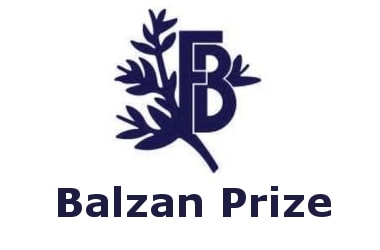 Two US scientists whose work has contributed to creating immunological treatments for cancer are among the winners of this year’s Balzan Prizes, recognising scholarly and scientific achievements.
Another winner is economist Bina Agarwal, a professor at the University of Manchester, who was recognised in the gender studies category for her “heroic” work studying women’s contributions to agriculture in India.
James Allison of the University of Texas MD Anderson Cancer Center and Robert Schreiber of the Washington University School of Medicine were cited for their work on antibody treatments that has increased the survival of patients with metastatic melanoma.
The Balzan Foundation awards two prizes in the sciences and two in the humanities each year, rotating specialities to highlight new or emerging areas of research and sustain fields that might be overlooked elsewhere.
Recipients receive 750,000 Swiss francs (₹5 crore), half of which must be used for research, preferably by young scholars or scientists.
Nobel Prize-winner Jules Hoffman, a presenter of the awards, said the work focusing on using the immune system to fight cancer, expanding from the traditional treatments of removal, radiation and chemotherapy, has already had success in 25 to 30% of melanoma patients. Two US scientists whose work has contributed to creating immunological treatments for cancer are among the winners of this year’s Balzan Prizes, recognising scholarly and scientific achievements.
Another winner is economist Bina Agarwal, a professor at the University of Manchester, who was recognised in the gender studies category for her “heroic” work studying women’s contributions to agriculture in India.
James Allison of the University of Texas MD Anderson Cancer Center and Robert Schreiber of the Washington University School of Medicine were cited for their work on antibody treatments that has increased the survival of patients with metastatic melanoma.
The Balzan Foundation awards two prizes in the sciences and two in the humanities each year, rotating specialities to highlight new or emerging areas of research and sustain fields that might be overlooked elsewhere.
Recipients receive 750,000 Swiss francs (₹5 crore), half of which must be used for research, preferably by young scholars or scientists.
Nobel Prize-winner Jules Hoffman, a presenter of the awards, said the work focusing on using the immune system to fight cancer, expanding from the traditional treatments of removal, radiation and chemotherapy, has already had success in 25 to 30% of melanoma patients.
|
▼ Google Drive to become extinct! [09-12-17]
 Google let fly an announcement that PC and Mac desktop app for Google Drive is going the way of the Dodo bird.
As the new alternative, customers will have two options.
For those using the G Suite service, the solution is called Drive File Stream, an app that will allow for quicker, more streamlined access to their files and also the ability to choose which ones are made available offline.
For non-G Suite users, another app called Backup and Sync will be the way to go.
It will have all the same features as the Google Drive desktop app that most users currently access on a regular basis, but with an added photo capability as well.
This seems to be a move towards making Google more of a one-stop shop for your online cloud storage.
The Backup and Sync app will allow users to store a large amount of photos, provided they're cool with the slight compression that will happen during the upload process.
If not, they'll have to pay extra for more storage.
After the debacle that was Google+, the company is hoping that, with this change, more customers will be housing all of their data in their infrastructure instead of with other providers. Google let fly an announcement that PC and Mac desktop app for Google Drive is going the way of the Dodo bird.
As the new alternative, customers will have two options.
For those using the G Suite service, the solution is called Drive File Stream, an app that will allow for quicker, more streamlined access to their files and also the ability to choose which ones are made available offline.
For non-G Suite users, another app called Backup and Sync will be the way to go.
It will have all the same features as the Google Drive desktop app that most users currently access on a regular basis, but with an added photo capability as well.
This seems to be a move towards making Google more of a one-stop shop for your online cloud storage.
The Backup and Sync app will allow users to store a large amount of photos, provided they're cool with the slight compression that will happen during the upload process.
If not, they'll have to pay extra for more storage.
After the debacle that was Google+, the company is hoping that, with this change, more customers will be housing all of their data in their infrastructure instead of with other providers.
|
▼ Pluto's mountain ranges named after explorers Sir Edmund Hillary and Tenzing Norgay [09-12-17]
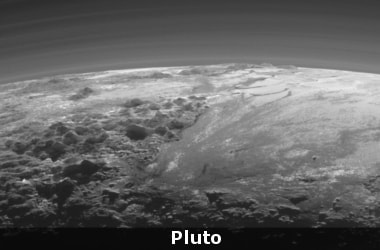 Two mountain ranges on Pluto have been named after Tenzing Norgay and Edmund Hillary respectively by the International Astronomical Union, which for the first time, has officially approved the naming of 14 features on the icy dwarf planet.
These are the first geological features on the planet to be named following the close flyby by the New Horizons spacecraft in July 2015.
The names pay homage to the underworld mythology, pioneering space missions, historic pioneers who crossed new horizons in exploration, and scientists and engineers associated with Pluto and the Kuiper Belt.
This is the first set of official names of surface features on Pluto to be approved by the Working Group for Planetary System Nomenclature of the International Astronomical Union (IAU), the internationally recognised authority for naming celestial bodies and their surface features.
NASA’s New Horizons team proposed the names to the IAU following the first reconnaissance of Pluto and its moons by the New Horizons spacecraft. Tenzing Montes and Hillary Montes are mountain ranges.
These are honouring Tenzing Norgay (1914-1986) and Sir Edmund Hillary (1919-2008), the Indian/Nepali Sherpa and New Zealand mountaineer who were the first to reach the summit of Mount Everest and return safely.
Other Names Two mountain ranges on Pluto have been named after Tenzing Norgay and Edmund Hillary respectively by the International Astronomical Union, which for the first time, has officially approved the naming of 14 features on the icy dwarf planet.
These are the first geological features on the planet to be named following the close flyby by the New Horizons spacecraft in July 2015.
The names pay homage to the underworld mythology, pioneering space missions, historic pioneers who crossed new horizons in exploration, and scientists and engineers associated with Pluto and the Kuiper Belt.
This is the first set of official names of surface features on Pluto to be approved by the Working Group for Planetary System Nomenclature of the International Astronomical Union (IAU), the internationally recognised authority for naming celestial bodies and their surface features.
NASA’s New Horizons team proposed the names to the IAU following the first reconnaissance of Pluto and its moons by the New Horizons spacecraft. Tenzing Montes and Hillary Montes are mountain ranges.
These are honouring Tenzing Norgay (1914-1986) and Sir Edmund Hillary (1919-2008), the Indian/Nepali Sherpa and New Zealand mountaineer who were the first to reach the summit of Mount Everest and return safely.
Other Names
- Other names had been used informally by the New Horizons science team to describe the many regions, mountain ranges, plains, valleys and craters discovered during the first close-up look at the surfaces of Pluto and its largest moon, Charon.
- The approved Pluto surface feature names include the Burney crater that honours Venetia Burney (1918-2009), who as an 11-year-old schoolgirl suggested the name “Pluto” for Clyde Tombaugh’s newly discovered planet.
- Sputnik Planitia is a large plain named after Sputnik 1, the first space satellite, launched by the Soviet Union in 1957.
- Djanggawul Fossae defines a network of long, narrow depressions named for the Djanggawuls, three ancestral beings in indigenous Australian mythology who travelled between the island of the dead and Australia, creating the landscape and filling it with vegetation.
- Sleipnir Fossa is named for the powerful, eight-legged horse of Norse mythology that carried the god Odin into the underworld.
- Virgil Fossae honours Virgil, one of the greatest Roman poets and Dante’s fictional guide through hell and purgatory in the Divine Comedy.
- Hayabusa Terra is a large land mass named in honour of the Japanese spacecraft and mission (2003-2010) that returned the first asteroid sample.
- Voyager Terra honours the pair of NASA spacecraft, launched in 1977, that performed the first “grand tour” of all four giant planets. Tartarus Dorsa is a ridge named for Tartarus, the deepest, darkest pit of the underworld in Greek mythology.
|
▼ New edible freshwater fish discovered in Pampa River! [09-12-17]
 Researchers exploring the waters of the Pampa river in Pathanamthitta have chanced upon a new species of edible freshwater fish that could possibly be farmed on a commercial scale.
The new species that belongs to the Labeo genus is only the second one to be reported from Kerala. Named Labeo filiferus, it has been collected from the stretch of the Pampa running through Edakadathy in Pathanamthitta.
The fishes in the Labeo genus are widely distributed in the inland waterbodies of India, Pakistan, Nepal, Bangladesh, Sri Lanka, Burma, Malaysia, tropical Africa and Syria.
They are medium- sized elongate fishes with rounded abdomen, swollen snout, finged lips and a straight lateral line.
As many as 31 species of Labeo are reported to be present in India, with L.rohita, commonly known as Rohu, extensively used in aquaculture.
The only other Labeo species reported from Kerala is L.dussumieri.
L. Filiferus: Know More Researchers exploring the waters of the Pampa river in Pathanamthitta have chanced upon a new species of edible freshwater fish that could possibly be farmed on a commercial scale.
The new species that belongs to the Labeo genus is only the second one to be reported from Kerala. Named Labeo filiferus, it has been collected from the stretch of the Pampa running through Edakadathy in Pathanamthitta.
The fishes in the Labeo genus are widely distributed in the inland waterbodies of India, Pakistan, Nepal, Bangladesh, Sri Lanka, Burma, Malaysia, tropical Africa and Syria.
They are medium- sized elongate fishes with rounded abdomen, swollen snout, finged lips and a straight lateral line.
As many as 31 species of Labeo are reported to be present in India, with L.rohita, commonly known as Rohu, extensively used in aquaculture.
The only other Labeo species reported from Kerala is L.dussumieri.
L. Filiferus: Know More
- According to the authors, L.filiferus was found to be distinct from the other species of the genus in its features including black coloured body and fins, prominent barbels, smaller eyes, longer snout and elongated dorsal and anal fins.
- The eyes are brilliantly coloured with orange tinge. The specimens were 20 to 40 cm long and weighed four to five kg.
- The name filiferus was taken from Latin (filum in latin means ‘thread’ and fero means ‘to bear’) and refers to the very long dorsal fin of the species.
- More species of the Labeo genus are expected to be discovered in the near future from the aquatic bodies in north and central Kerala.
|
▼ New online service for resolving foreign trade issues [09-12-17]
 The Government has set up an online service facility that can be used by importers and exporters to resolve all foreign trade-related issues.
The Directorate General of Foreign Trade (DGFT), which comes under the Commerce Ministry, has asked all exporters and importers to use the system - Contact@DGFT - for resolution of their matters.
Traders can raise all matters related to the directorate or other agencies of the Centre and States through this facility, which is activated at the DGFT website.
Contact@DGFT system has been activated as a single point contact for resolving all foreign trade-related issues, for all regional authorities, export promotion councils, commodity boards and members of trade and industry.
It said best efforts will be made for expeditious resolution.
In the interest of systematic monitoring and effective resolution, exporters/importers are requested not to send their queries through twitter or e-mail and use Contact@DGFT service instead. The Government has set up an online service facility that can be used by importers and exporters to resolve all foreign trade-related issues.
The Directorate General of Foreign Trade (DGFT), which comes under the Commerce Ministry, has asked all exporters and importers to use the system - Contact@DGFT - for resolution of their matters.
Traders can raise all matters related to the directorate or other agencies of the Centre and States through this facility, which is activated at the DGFT website.
Contact@DGFT system has been activated as a single point contact for resolving all foreign trade-related issues, for all regional authorities, export promotion councils, commodity boards and members of trade and industry.
It said best efforts will be made for expeditious resolution.
In the interest of systematic monitoring and effective resolution, exporters/importers are requested not to send their queries through twitter or e-mail and use Contact@DGFT service instead.
|
▼ DRDO's home made ATAGS shoots farther than any other gun! [09-11-17]
 DRDO’s home made ATAGS (Advanced Towed Artillery Gun System) of which nearly 2,000 examples will soon equip the various units of the artillery regiment, has just proved itself to be a devastating weapon.
During the recently conducted field trials at the Pokhran range, the gun fired three shells out to a range of 47.2 kms.
This is farther than any other gun in the world!
The 155 mm 52-calibre gun is now a world record holder.
During tests, the gun fired a long range ‘High explosive – base bleed’ round. Most 155mm guns in the world max out between 40 km and 45 kms.
According to a Sputnik report, the reason for the longer range of the ATAGS is the 25-litre volume of its chamber that allows higher quantities of propellant to be used.
Other similar guns have a chamber of about 23-litre capacity.
The gun is also unique in having a six-round magazine that gives it a higher rate of fire compared to three-round magazines in others. DRDO’s home made ATAGS (Advanced Towed Artillery Gun System) of which nearly 2,000 examples will soon equip the various units of the artillery regiment, has just proved itself to be a devastating weapon.
During the recently conducted field trials at the Pokhran range, the gun fired three shells out to a range of 47.2 kms.
This is farther than any other gun in the world!
The 155 mm 52-calibre gun is now a world record holder.
During tests, the gun fired a long range ‘High explosive – base bleed’ round. Most 155mm guns in the world max out between 40 km and 45 kms.
According to a Sputnik report, the reason for the longer range of the ATAGS is the 25-litre volume of its chamber that allows higher quantities of propellant to be used.
Other similar guns have a chamber of about 23-litre capacity.
The gun is also unique in having a six-round magazine that gives it a higher rate of fire compared to three-round magazines in others.
|
▼ Now, add text to video call on WhatsApp [09-11-17]
 WhatsApp has lately been trying its hands-on different features on its platform.
In July this year, the Facebook-owned messaging app rolled out a testing version of picture-in-picture feature for video calling on Android O.
Now, the WhatsApp has rolled out the support for picture-in-picture mode to its users across the globe. Apart from that, the company has also added the ability to put text as a status message.
The first feature is called picture-in-picture.
After rolling out the picture-in-picture (PIP) video calls to beta users of its app, WhatsApp has now rolled out the feature to everyone.
This means both Android and iOS users will now be able to minimize video calling window and move it around while browsing through other messages in the background.
When in a video call, you can tap back to continue the video call in picture-in-picture mode.
The picture-in-picture video calls update will only be available for Android users whose smartphones have been updated to Android 8.0 Oreo.
For iOS users, the feature works fine on iOS 10.
The second feature allows you to post text-only updates to your status. The status, just like the photos and videos will be visible for a time interval of 24 hours.
WhatsApp Changes: Know More WhatsApp has lately been trying its hands-on different features on its platform.
In July this year, the Facebook-owned messaging app rolled out a testing version of picture-in-picture feature for video calling on Android O.
Now, the WhatsApp has rolled out the support for picture-in-picture mode to its users across the globe. Apart from that, the company has also added the ability to put text as a status message.
The first feature is called picture-in-picture.
After rolling out the picture-in-picture (PIP) video calls to beta users of its app, WhatsApp has now rolled out the feature to everyone.
This means both Android and iOS users will now be able to minimize video calling window and move it around while browsing through other messages in the background.
When in a video call, you can tap back to continue the video call in picture-in-picture mode.
The picture-in-picture video calls update will only be available for Android users whose smartphones have been updated to Android 8.0 Oreo.
For iOS users, the feature works fine on iOS 10.
The second feature allows you to post text-only updates to your status. The status, just like the photos and videos will be visible for a time interval of 24 hours.
WhatsApp Changes: Know More
- WhatsApp has been trying to bring in many new features on the app recently.
- Very recently, WhatsApp introduced a number of changes to its iOS and Android app.
- These features include the ability to pin favourite chats on top of the conversation list and the option to forward or delete shared images as one whole album.
- WhatsApp for Business is another feature that has been in news for a while now.
- It is currently testing new tools and the app is said to be free for small-scale companies. Large firms with a global base of customers will have to get the enterprise version of the app that might be a paid one.
- The feature will let business get company’s solutions to provide customers with useful notifications like flight times, scheduled, arrival, delays, offers and other updates.
|
▼ Scientists make fuel out of thin air! [09-11-17]
 Scientists have found a way to produce methanol - an important chemical often used as fuel in vehicles - using oxygen in the air, an advance that may lead to cleaner, greener industrial processes worldwide.
Methanol is currently produced by breaking down natural gas at high temperatures into hydrogen gas and carbon monoxide before reassembling them - expensive and energy-intensive processes known as ‘steam reforming’ and ‘methanol synthesis.’
However, researchers from Cardiff University in the U.K. have discovered they can produce methanol from methane through simple catalysis that allows methanol production at low temperatures using oxygen and hydrogen peroxide.
At present global natural gas production is about 2.4 billion tonnes per annum and 4% of this is flared into the atmosphere - roughly 100 million tonnes.
The approach of using natural gas could use this “waste” gas saving, saving carbon dioxide emissions. Scientists have found a way to produce methanol - an important chemical often used as fuel in vehicles - using oxygen in the air, an advance that may lead to cleaner, greener industrial processes worldwide.
Methanol is currently produced by breaking down natural gas at high temperatures into hydrogen gas and carbon monoxide before reassembling them - expensive and energy-intensive processes known as ‘steam reforming’ and ‘methanol synthesis.’
However, researchers from Cardiff University in the U.K. have discovered they can produce methanol from methane through simple catalysis that allows methanol production at low temperatures using oxygen and hydrogen peroxide.
At present global natural gas production is about 2.4 billion tonnes per annum and 4% of this is flared into the atmosphere - roughly 100 million tonnes.
The approach of using natural gas could use this “waste” gas saving, saving carbon dioxide emissions.
|
▼ Brightest solar flare in this sun cycle recorded [09-8-17]
 Two high-intensity solar flares were emitted, the second of which was the most intense recorded since the start of this sun cycle in December 2008, NASA said.
These radiation flares, which can disrupt communications satellites, GPS and power grids by reaching the upper Earth atmosphere, were detected and captured by the US Space Agency's Solar Dynamics Observatory.
According to the Space Weather Prediction Center (SWPC), these so-called category X eruptions disrupted high-frequency radio communications for one hour on the Earth's side facing the sun and low-frequency communications used in navigation.
The two eruptions occurred in an active region of the sun where an eruption of average intensity occurred on September 4.
The current cycle of the sun, which began in December 2008, saw the intensity of solar activity decline sharply, opening the way to the “solar minimum.”
Solar Cycles and Solar Flares: Know More Two high-intensity solar flares were emitted, the second of which was the most intense recorded since the start of this sun cycle in December 2008, NASA said.
These radiation flares, which can disrupt communications satellites, GPS and power grids by reaching the upper Earth atmosphere, were detected and captured by the US Space Agency's Solar Dynamics Observatory.
According to the Space Weather Prediction Center (SWPC), these so-called category X eruptions disrupted high-frequency radio communications for one hour on the Earth's side facing the sun and low-frequency communications used in navigation.
The two eruptions occurred in an active region of the sun where an eruption of average intensity occurred on September 4.
The current cycle of the sun, which began in December 2008, saw the intensity of solar activity decline sharply, opening the way to the “solar minimum.”
Solar Cycles and Solar Flares: Know More
- Solar cycles last on average eleven years.
- At the end of the active phase, these eruptions become increasingly rare but still can be powerful.
- Solar storms result from an accumulation of magnetic energy in some places.
- These jets of ionized matter are projected–at high speed into and beyond the crown of the sun– hundreds of thousands of kilometres outward.
- NASA has recorded the biggest solar flare for 12 years as the sun unleashed an X-Class flare on September 6.
- The flare, which peaked at 8.02am EDT, caused a radio blackout following the “shock arrival” of radiation from the sun.
- The solar flare was the largest recorded since September 2005, when an X17 was released.
X-class represents the most intense solar flares, with an X2 being twice as intense as an X1.
- The largest solar flare ever recorded was an X20 in April 2001.
- Harmful radiation from a flare cannot pass through Earth's atmosphere to physically affect humans on the ground, however - when intense enough - they can disturb the atmosphere in the layer where GPS and communications signals travel.
CME and Solar Flares- CMEs and solar flares are different phenomena but often occur at the same time when it comes to the strongest solar flares.
- Both are created when the sun’s interior contorts its own magnetic fields—as the magnetic field snaps like a rubber band it releases a huge amount of energy into space.
- The flash of light and high energy particles released is the solar flare, while the solar matter from the magnetic contortions are CMEs.
- A huge solar storm in 1859 - known as the Carrington Event - caused telegraph systems across Europe and North America to fail and auroras associated with the solar winds could be seen as far south as the Caribbean.
- If a similar sized storm hit today, it is estimated it could cost around $2 trillion.
|
▼ SpaceX on super secret mission X-37B [09-8-17]
 On the tarmac, the X-37B, as it is called, looks tiny, standing not much taller than a person. Its wingspan measures less than 15 feet, and it weighs in at just 11,000 pounds.
But over the course of six flights, it has proved to be a rugged little robotic spacecraft, spending a total of nearly six years, probing the hard environment of the high frontier.
On Sept 7, 2017, after a successful morning launch at Cape Canaveral Air Force Station in Florida, the X-37B headed yet again to the vital real estate known as low Earth orbit, home to the International Space Station and all sorts of military and commercial satellites.
The mission is slated to last 270 days, but the Air Force warned in a statement that “the actual duration depends on test objectives, on-orbit vehicle performance and conditions at the landing facility.”
The primary objectives of the X-37B are twofold: reusable spacecraft technologies for America's future in space and operating experiments which can be returned to, and examined, on Earth.
On this flight, the mission is to carry small satellites, demonstrate greater opportunities for rapid space access and on-orbit testing of emerging space technologies.
The service also said it would test experimental electronics in a weightless environment.
The mission is also significant because it marked the first time SpaceX has been chosen to launch for the Air Force - a coup for the California firm started in 2002 by tech entrepreneur Elon Musk.
The X-37B was launched on top of a SpaceX Falcon 9 rocket.
SpaceX also successfully landed the first stage of its Falcon 9 rocket on a landing pad on the Cape, a bit of rocket artistry that Musk and others have said could help dramatically lower the cost of space travel.
Background On the tarmac, the X-37B, as it is called, looks tiny, standing not much taller than a person. Its wingspan measures less than 15 feet, and it weighs in at just 11,000 pounds.
But over the course of six flights, it has proved to be a rugged little robotic spacecraft, spending a total of nearly six years, probing the hard environment of the high frontier.
On Sept 7, 2017, after a successful morning launch at Cape Canaveral Air Force Station in Florida, the X-37B headed yet again to the vital real estate known as low Earth orbit, home to the International Space Station and all sorts of military and commercial satellites.
The mission is slated to last 270 days, but the Air Force warned in a statement that “the actual duration depends on test objectives, on-orbit vehicle performance and conditions at the landing facility.”
The primary objectives of the X-37B are twofold: reusable spacecraft technologies for America's future in space and operating experiments which can be returned to, and examined, on Earth.
On this flight, the mission is to carry small satellites, demonstrate greater opportunities for rapid space access and on-orbit testing of emerging space technologies.
The service also said it would test experimental electronics in a weightless environment.
The mission is also significant because it marked the first time SpaceX has been chosen to launch for the Air Force - a coup for the California firm started in 2002 by tech entrepreneur Elon Musk.
The X-37B was launched on top of a SpaceX Falcon 9 rocket.
SpaceX also successfully landed the first stage of its Falcon 9 rocket on a landing pad on the Cape, a bit of rocket artistry that Musk and others have said could help dramatically lower the cost of space travel.
Background
- For nearly a decade, the United Launch Alliance, the joint venture between Lockheed Martin and Boeing, had a monopoly on Pentagon launches.
- SpaceX filed suit against the Air Force for the right to compete.
- In 2015, the parties settled and SpaceX was ultimately allowed to compete against ULA, opening up a potentially lucrative source of revenue.
- Since then, SpaceX has won two of three contested launch contracts.
- X37B marks SpaceX's first military mission after years of launching payloads for NASA and commercial satellites.
- All four of the X-37B's previous launches were aboard ULA's Atlas V rocket.
- The last X-37B flight lasted almost two years, setting a new endurance record for the drone. Over the course of five missions, it has spent almost six years in space.
- The reusable, solar-powered “orbital space vehicle” was developed by Boeing Co. BA, +0.72%.
|
▼ Voyager 1 completes 40th anniversary [09-8-17]
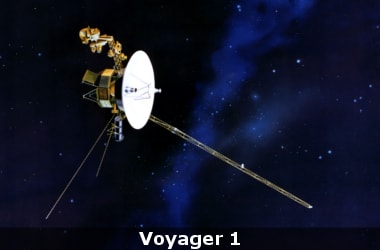 The farthest record of Earth and humanity is approximately 13 billion miles from our planet, traveling out of the solar system on its way toward the unknown, perhaps intelligent life.
The Voyager 1 spacecraft was launched 40 years ago Tuesday, carrying with it a “Golden Record” of what Earth has produced.
This ranges from the raucous 2:38 recording of Chuck Berry’s “Johnny B. Goode” and Azerbaijani bagpipes recorded by Radio Moscow in the 1970s, to images of human cities and people, to greetings to the rest of the universe recorded in 55 different languages.
The Smithsonian National Air and Space Museum held a celebration of the 40th anniversary Tuesday morning. (Voyager 2 had been launched a few weeks prior, on Aug. 20, 1977).
The twin spacecraft were originally aimed to explore Jupiter and Saturn, with their 8-track recording devices and each with a copy of the Golden Record.
But they are currently far beyond those objectives, probing far out along the frontier where our solar system meets interstellar space.
Scientists who helped launch the mission have reportedly said that the long-lived missions have surprised even them.
Voyager 2 is the only spacecraft to visit Uranus and Neptune, and was the first to send back pictures of the rings of those two planets, as well as Jupiter.
The two spacecraft discovered active volcanoes on Io, multiple moons at Jupiter, Saturn, Uranus, and Neptune, and also lightning on Jupiter.
They two crafts continue to send back information daily. They are currently measuring cosmic rays and galactic magnetic fields in interstellar space, as well as solar wind termination shock
This was our chance to create a kind of Noah’s Ark of human culture. The farthest record of Earth and humanity is approximately 13 billion miles from our planet, traveling out of the solar system on its way toward the unknown, perhaps intelligent life.
The Voyager 1 spacecraft was launched 40 years ago Tuesday, carrying with it a “Golden Record” of what Earth has produced.
This ranges from the raucous 2:38 recording of Chuck Berry’s “Johnny B. Goode” and Azerbaijani bagpipes recorded by Radio Moscow in the 1970s, to images of human cities and people, to greetings to the rest of the universe recorded in 55 different languages.
The Smithsonian National Air and Space Museum held a celebration of the 40th anniversary Tuesday morning. (Voyager 2 had been launched a few weeks prior, on Aug. 20, 1977).
The twin spacecraft were originally aimed to explore Jupiter and Saturn, with their 8-track recording devices and each with a copy of the Golden Record.
But they are currently far beyond those objectives, probing far out along the frontier where our solar system meets interstellar space.
Scientists who helped launch the mission have reportedly said that the long-lived missions have surprised even them.
Voyager 2 is the only spacecraft to visit Uranus and Neptune, and was the first to send back pictures of the rings of those two planets, as well as Jupiter.
The two spacecraft discovered active volcanoes on Io, multiple moons at Jupiter, Saturn, Uranus, and Neptune, and also lightning on Jupiter.
They two crafts continue to send back information daily. They are currently measuring cosmic rays and galactic magnetic fields in interstellar space, as well as solar wind termination shock
This was our chance to create a kind of Noah’s Ark of human culture.
|
▼ Common cuckoo’s clever strategy to scare reed warblers [09-6-17]
 The common cuckoo, notorious for evading parental duty by hiding her eggs in the nests of other brooding birds, is even more devious than previously thought, scientists revealed.
After laying an egg, the female distracts the owner of the nest - a reed warbler in this case - essentially by frightening the poor bird out of its wits.
The cuckoo gives a “chuckle” that mimics the call of the sparrow hawk - which loves to snack on warbler flesh - before abandoning her egg among the warbler’s clutch and flying off to freedom.
This hawk-like chuckle call increases the success of parasitism by diverting host parents’ attention away from the clutch and towards their own safety. The common cuckoo, notorious for evading parental duty by hiding her eggs in the nests of other brooding birds, is even more devious than previously thought, scientists revealed.
After laying an egg, the female distracts the owner of the nest - a reed warbler in this case - essentially by frightening the poor bird out of its wits.
The cuckoo gives a “chuckle” that mimics the call of the sparrow hawk - which loves to snack on warbler flesh - before abandoning her egg among the warbler’s clutch and flying off to freedom.
This hawk-like chuckle call increases the success of parasitism by diverting host parents’ attention away from the clutch and towards their own safety.
|
▼ CERT-in issues Locky ransomware alert [09-5-17]
 The Indian Computer Emergency Response Team (CERT-In) on Sept 1, 2017 issued an alert about spread of a new malicious software ‘Locky’, which is being circulated through spam messages. The Indian Computer Emergency Response Team (CERT-In) on Sept 1, 2017 issued an alert about spread of a new malicious software ‘Locky’, which is being circulated through spam messages.
This is a ransomware that can potentially lock computers and demand ransom for restoring access to users.
Reports indicate that over 23 million messages are being sent in this campaign.
Locky Ransomware is learnt to be demanding ransom of half bitcoin, which at present rate is equivalent to over Rs 1.5 lakh.
The alert, issued on Cyber Swachhta Kendra, said it has been reported that a new wave of spam mails is circulating with common subject lines to spread variants of Locky Ransomware.
To target users, it added, spam e-mails showing links to fake websites is being used to spread Locky variants.
Users are advised to exercise caution while opening e-mails and organisations are advised to deploy anti-spam solutions and update spam block lists.
This is the third major ransomware attack this year after Wannacry and Petya that crippled thousands of computers, including those of multinational corporations.
In fact, according to an Assocham PWC study, India was the third worst affected country in a list of over 100 countries hit by Wannacry in May.
|
▼ Mission Breakthrough Listen detects possible alien life [09-5-17]
 A mission to explore intelligent alien life in the universe has recorded some mysterious signals coming from a galaxy three billion light years away, according to an Indian-origin scientist working on the ambitious project co-founded by Stephen Hawking. A mission to explore intelligent alien life in the universe has recorded some mysterious signals coming from a galaxy three billion light years away, according to an Indian-origin scientist working on the ambitious project co-founded by Stephen Hawking.
The team working under the Breakthrough Listen project - set up by Hawking, one of the world’s best-known scientists, and Russian billionaire Yuri Milner - is set to discover the truth about the universe.
The latest fast radio bursts (FRBs) prove their equipment is working well and ready to pick up signs of life if they exist.
Breakthrough Listen is a USD 100-million global astronomical initiative launched in 2015 by Hawking and Miller and has teams around the world using their telescopes to look for evidence of life.
The initial 10-year programme will survey the 1,000,000 closest stars to Earth, scanning the entire galactic plane of the Milky Way.
Beyond our galaxy it will listen for messages from the 100 closest galaxies at 10 billion different frequencies.
Announcing the project at the time at a press conference in London, Hawking said it was time to commit to finding the answer to life beyond Earth.
Explanations for the latest signals detected range from rotating neutron stars with extremely magnetic fields, to energy sources used by extraterrestrial civilisations to power spacecraft.
Whatever they are they left their galaxy when our Solar System was just two billion years old and life was just getting going on Earth.
At first scientists thought the signals were the fallout from a catastrophic event in space, like a supernova, but then they repeated again in 2015 and 2016 suggesting the whatever object produced them was still there.
In the fresh experiment, which will be elaborated upon in scientific journals in future, University of California, Berkeley, experts scanned the same galaxy at a higher frequency than which had been used to see the original bursts, and found 15 more.
|
▼ TRAPPIST-1 planets found to contain water [09-5-17]
 The Earth-sized planets orbiting the ultracool TRAPPIST-1 dwarf star 40 light-years away may have substantial amounts of water and could be habitable. The Earth-sized planets orbiting the ultracool TRAPPIST-1 dwarf star 40 light-years away may have substantial amounts of water and could be habitable.
An international team of astronomers used the NASA/ESA Hubble Space Telescope to estimate whether there might be water on the seven planets orbiting in the nearby TRAPPIST-1 planetary.
The results suggest that the outer planets of the system might still harbour substantial amounts of water.
This includes the three planets within the habitable zone of the star, lending further weight to the possibility that they may indeed be habitable.
This makes TRAPPIST-1 the planetary system with the largest number of Earth-sized planets discovered so far.
Following up on the discovery, scientists used the Space Telescope Imaging Spectrograph (STIS) on the Hubble telescope to study the amount of ultraviolet radiation received by the individual planets of the system.
While lower-energy ultraviolet radiation breaks up water molecules - a process called photodissociation - ultraviolet rays with more energy (XUV radiation) and X-rays heat the upper atmosphere of a planet, which allows the products of photodissociation, hydrogen and oxygen, to escape.
As it is very light, hydrogen gas can escape the exoplanets’ atmospheres and be detected around the exoplanets with Hubble, acting as a possible indicator of atmospheric water vapour.
The observed amount of ultraviolet radiation emitted by TRAPPIST-1 suggests that the planets could have lost gigantic amounts of water over the course of their history.
|
▼ Meet Hortinet - Mobile app for horticulture [09-4-17]
 Hortinet is an integrated traceability system developed by APEDA. Hortinet is an integrated traceability system developed by APEDA.
To harness the potential of mobile technology, APEDA has developed a mobile app to allow farmers to apply on-line to facilitate their farm registration, tracking the status of application & approvals by State Government and Lab sampling by authorized Laboratories.
This mobile app initiative is expected to increase the accessibility and reach of the Traceability software system among the farmers and other stakeholders.
This new Mobile app will also assist State Horticulture/ Agriculture Department to capture real time details of farmers, farm location, products and details of inspections like date of inspection, name of inspecting directly from field. After registration and approval of farm, farmer gets approval information.
Commerce Secretary, Government of India, Smt Rita Teaotia launched the app. The occasion was followed by display of a film depicting all the facets of the utility of the new app.
|
▼ DBT launched conclave to set up FarmerZone [09-1-17]
 The Department of Biotechnology (DBT), under the Ministry of Science and Technology, convened the Smart Agriculture Conclave in New Delhi from August 29-31 2017. The Department of Biotechnology (DBT), under the Ministry of Science and Technology, convened the Smart Agriculture Conclave in New Delhi from August 29-31 2017.
This is in partnership with the UK’s Biotechnology and Biological Sciences Research Council (BBSRC) and Research Councils UK (RCUK) India.
The objective of this conclave was to set the stage for “FarmerZone” - a collective open-source data platform for smart agriculture which will use biological research and data to improve the lives of small and marginal farmers.
It is envisaged that “FarmerZone” will help cater to all needs of the farmer, from dealing with climate change, weather predictions and soil, water, and seed requirements to providing market intelligence.
FarmerZone has been envisioned by the DBT and aligns with the Indian Prime Minister, Mr. Narendra Modi’s call for effective decision-making in agriculture that integrates science, technology, innovation and the farm ecosystem.
With the agricultural conclave, DBT aims to advance the process of technological intervention to help small and marginal land-holding farmers, who constitute a major component of Indian agriculture.
The conclave identified the challenges faced in each agro-climatic region, and discussed possible solutions through scientific interventions.
FarmerZone: Know More
- The FarmerZone platform will connect farmers and scientists, government officials, thought leaders in agriculture, economists and representatives from global companies who work in the big-data and e-commerce space to bring about technology-based localised agri-solutions.
- The platform will work on getting relevant quality data related to agriculture into the cloud, develop sentinel sites to help link with farmers and evolve PPP based enterprises for data delivery.
- Food security is a global concern and the livelihoods of hundreds of millions of families depend on small-scale agriculture.
- The conclave worked to address this challenge collectively and showcased the enormous research strength of India and its international partners in a global context, to achieve impact and build strong and sustainable research and innovation partnerships.
|
▼ Researchers at IIT create bioartificial pancreas model [09-1-17]
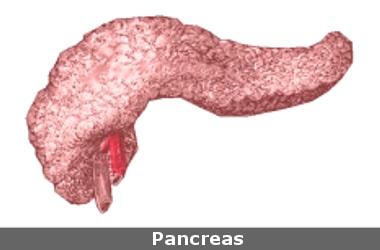 Researchers at the Indian Institute of Technology (IIT) Guwahati have successfully created an implantable bioartificial pancreas model grown within a 3D silk scaffold. Researchers at the Indian Institute of Technology (IIT) Guwahati have successfully created an implantable bioartificial pancreas model grown within a 3D silk scaffold.
The “pancreas”, which encapsulates insulin-producing cells, is capable of naturally producing insulin in a sustained manner.
If successful in animal and human trials, it can be used for treating people with type 1 diabetes.
The silk scaffold was found to be biocompatible (not toxic to living tissue) as it did not trigger any immune reaction.
The silk scaffold (6 mm in diameter and 2 mm in thickness) was made porous by using salt grains of specific size to dissolve the silk proteins.
The pores - 400 - 500 micrometre in size - allowed glucose and oxygen to enter the scaffold and insulin released by the beta cells to enter the bloodstream;
There was also greater cell survival. Insulin producing beta cells taken from 8 - to 10 - week-old rats were added to the scaffold.
Type 1 diabetes arises when the body’s immune system kills the insulin-producing beta cells.
Since type 1 diabetes patients do not have insulin-producing beta cells, the researchers have turned to stem cells to produce beta cells.
|